- Business Plan for Investors
- Bank/SBA Business Plan
- Operational/Strategic Planning Services
- L1 Visa Business Plan
- E1 Treaty Trader Visa Business Plan
- E2 Treaty Investor Visa Business Plan
- EB-1 Business Plan
- EB-2 NIW Business Plan
- EB-5 Business Plan
- Innovator Founder Visa Business Plan
- Start-Up Visa Business Plan
- Expansion Worker Visa Business Plan
- Manitoba MPNP Visa Business Plan
- Nova Scotia NSNP Visa Business Plan
- British Columbia BC PNP Visa Business Plan
- Self-Employed Visa Business Plan
- OINP Entrepreneur Stream Business Plan
- LMIA Owner Operator Business Plan
- ICT Work Permit Business Plan
- LMIA Mobility Program – C11 Entrepreneur Business Plan
- USMCA (ex-NAFTA) Business Plan
- Franchise Business Plan
- Landlord business plan
- Nonprofit Start-Up Business Plan
- USDA Business Plan
- Cannabis business plan
- Ecommerce business plan
- Online boutique business plan
- Mobile application business plan
- Daycare business plan
- Restaurant business plan
- Food delivery business plan
- Real estate business plan
- Business Continuity Plan
- Pitch Deck Consulting Services
- Financial Due Diligence Services
- ICO whitepaper
- ICO consulting services
- Confidential Information Memorandum
- Private Placement Memorandum
- Feasibility study
- Fractional CFO
- How it works
- Business Plan Examples

Fried Chicken Shop Business Plan
AUG.29, 2023
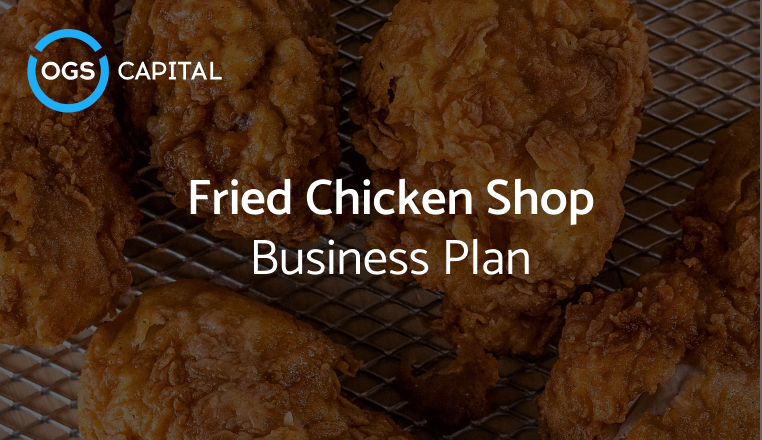
What Is a Fried Chicken Restaurant Business Plan?
Across many cultures, fried chicken is quite popular. Stepping into the world of a successful chicken shop requires some smart planning. That’s where a well-crafted fried chicken restaurant business plan comes into play.
A solid business plan, like the food delivery service business plan , should clearly define your ideal customers and highlight what makes your business uniquely appealing compared to competitors.
But that’s not all – with this plan, you can lay out your financial predictions to catch the eye of potential investors and lenders. So, if you’re aiming to create a thriving chicken hotspot, a rock-solid business plan is your secret ingredient.
Why Do You Need a Fried Chicken Store Business Plan?
A solid fried chicken shop business plan is critical for several reasons:
- Defines your vision, mission, and goals for the chicken shop.
- Analyzes your target market and customer needs.
- Evaluates competitors and your positioning.
- Plans efficient operations and resource allocation.
- Mitigates risks and challenges.
- Attracts investors by demonstrating viability and profitability.
- Secures funding with financial projections and assumptions.
In short, a strong business plan is key to launching and running a successful chicken shop.
How To Write a Fried Chicken Fast Food Restaurant Business Plan?
Writing a solid chicken shop business plan from scratch is extremely challenging, especially if you’re a beginner entrepreneur. Doing thorough industry research, defining your strategy, and creating detailed financial projections require significant time and business expertise.
Trying to put together all these complex components into a coherent plan can be overwhelming. This is why it’s highly recommended to use a fried chicken business plan example , template or sample.
Templates and samples provide structure, content examples and important questions to guide you. They save you time and effort while ensuring you cover all key sections properly. If you need more hands-on help, hiring franchise business plan consultants is a wise decision. They have the experience to craft a customized plan that secures funding and sets your chicken shop up for success.
Fried Chicken Shop Business Plan Sample
Here are the key elements that every fried chicken business plan should cover explained using a business template of Fried Chicken Express:
1. Executive Summary
Fried Chicken Express is a modern fast casual restaurant focused on serving fresh, crispy fried chicken and sides at reasonable prices. Our mission? To be the go-to spot for high-quality fried chicken in the neighborhood.
On the menu: wings, tenders, nuggets, sandwiches, wraps, salads, sides, sauces, drinks and desserts. We use premium ingredients and time-tested recipes to craft each item. The food comes packaged in eco-friendly containers to keep it tasting great.
Our target customer? Folks looking for a quick, satisfying chicken fix. We aim to appeal to young professionals, students and families who live or work nearby. Out-of-town visitors are also welcome. We offer value, quality, variety, convenience and rewards to bring customers back.
As highlighted in our feasibility study for restaurant , the fried chicken market is highly competitive with major brands like KFC, Popeyes. and Chick-fil-A. But we have some key advantages:
- Our fresh, crispy chicken at affordable prices
- Prime location with lots of foot traffic
- Modern, inviting store
- Friendly, efficient staff
- Savvy social media and word-of-mouth marketing
We need $200,000 to get up and running. This covers costs like leasing, renovations, equipment, inventory, staff, licenses and marketing. We expect to break even within 12 months and earn $50,000 profit in year one. Steady 15% annual growth is projected over the next five years.
Fried Chicken Express has big potential. For investors interested in supporting a promising new food venture, this is an opportunity with excellent returns. We aim to become the top local fried chicken brand with your partnership.
2. Company Analysis
At Fried Chicken Express, our mission is simple: serve fresh, crispy, craveable fried chicken in a clean and comfortable setting with friendly service. We aim to satisfy our customers’ fried chicken cravings with high-quality food, convenience and a positive experience every visit. Our goal is to create happy and loyal customers who feel appreciated.
3. Structure and Background
Fried Chicken Express is a sole proprietorship owned by Alan E. Greenberg, an experienced entrepreneur and chef. With over 10 years in the restaurant industry, Alan has developed extensive expertise in food preparation, menu development, kitchen management and marketing.
Noticing a lack of affordable yet delicious fried chicken options locally, Alan decided to leverage his passion for fried chicken and start Fried Chicken Express. Located at 1364 Cameron Road in Buffalo, NY, the 1,000 square foot restaurant can seat 40 guests in a modern, inviting dining space.
Fried Chicken Express is open daily from 10am-10pm and staffed by Alan as owner/manager along with 2 chefs, 4 servers, 2 cashiers and a cleaner. Alan personally trains staff to uphold the restaurant’s standards for fresh, hand-breaded fried chicken cooked to crispy perfection.

4. Market (industry) Analysis
Valued at $759.9 billion globally in 2022, the fast food market is forecast to grow steadily at 4.9% CAGR through 2028 (Source – Expert Market Research ). Key factors driving the growth of the fast food industry include:
- High demand for convenient meal options from time-pressed consumers
- Proliferation of fast food outlets across locations and channels
- Menu innovation and diversification catering to diverse tastes
- Rising online ordering, delivery and drive-thru for added convenience
- Growing preference for fresh, high-quality options among health-conscious diners
The take-out fried chicken market is projected to grow from $6.85 billion in 2023 to $10.52 billion by 2032, a 5.5% CAGR (Source – Market Research Future ). Key factors driving the growth of the fried chicken industry include:
- Chicken’s widespread popularity as an affordable, versatile protein source
- Abundant, low-cost chicken supply in the U.S.
- Diverse flavors and preparations meeting various consumer preferences
- Strong brand recognition and loyalty for established chains
- Rising demand for fresh, high-quality customized chicken products
With chicken a staple ingredient and product innovation aligned to changing consumer tastes, the outlook for fried chicken remains positive. Established brands enjoy an advantage, but there are opportunities for new entrants focused on quality, flavorful fare.
5. Competitor Analysis
Fried Chicken Express faces fierce competition in New York from major chains and local restaurants offering their own styles of fried chicken. The top competitors are:
1. Chick-fil-A
- Largest U.S. fried chicken chain with over 2,600 locations nationally
- 23 NYC locations, including 12 in Manhattan
Signature Menu Offering
- Breaded chicken sandwich: boneless breast, pickles, buttered bun
Product Range
- Expansive: nuggets, strips, salads, wraps, sides, sauces
- Varieties: grilled, spicy, deluxe
- Strong brand image and loyal customer base
- Wide product selection
- Consistent food quality
- Excellent customer service
- High prices compared to competitors
- Limited customization options
- Conservative corporate values
- Closed on Sundays
Competitive Position
- Major player in NYC’s fried chicken market
- Quality and service hard for new entrants to rival
- Widespread locations and devoted fans pose significant challenge
- Second largest U.S. fried chicken chain with over 4,000 locations
- 64 NYC locations including 25 in Manhattan
- Original Recipe chicken made with 11 secret herbs and spices
- Buckets, meals, sandwiches, wraps, bowls, salads, sides
- Flavors: Original Recipe, Extra Crispy, Grilled
- Strong global brand recognition
- Large existing customer base
- Diverse menu and low prices
- Innovative marketing campaigns
- Perceptions of poor food quality
- Unhealthy product image
- Lack of differentiation from competitors
- Social and environmental issues
- Major national player with significant NYC presence
- Brand awareness helps attract customers
- But food quality concerns persist
- Third largest U.S. fried chicken chain with over 3,000 locations
- 42 NYC locations including 14 in Manhattan
- Kanto-style fried chicken marinated in Cajun spices
- Fried chicken pieces, tenders, nuggets, sandwiches, wraps, bowls, salads, sides
- Flavors: Mild, Spicy, Blackened, Cajun Sparkle
- Unique New Orleans-inspired flavor profile
- Loyal customer base
- Broad menu and good value
- Relatively high prices
- Inconsistent customer service
- Supply chain challenges
- Established brand with significant NYC presence
- Louisiana-style chicken attracts fans
- But operational issues like service inconsistencies need improvement
4. Local NY Fried Chicken Restaurants
- Long standing local eateries like Sylvia’s, Pies ‘n’ Thighs, Charles’ Country Pan Fried Chicken, Peaches HotHouse
- Each has 1-3 locations, concentrated in specific neighborhoods
- Varying fried chicken styles: Southern, Nashville, Brooklyn, Harlem
- Secret recipes, niche flavors
- Cult followings of loyal neighborhood customers
- Lower prices than chains
- Customization and authenticity
- Small scale limits brand awareness
- Inconsistent quality control
- Limited marketing budgets
- Beloved community staples with devoted fans
- But small size and operational challenges limit competitiveness
To stand out, Fried Chicken Express must leverage quality, service and local brand-building with menu innovation and competitive pricing. Strong positioning is key against deep-pocketed chains and entrenched neighborhood favorites.
6. Products
Fried Chicken Express offers delicious fried chicken in a variety of styles to satisfy all cravings. Our core products:
- Wings – Crispy fried chicken wings in 4 flavors: Original, Spicy, Sweet, and Tangy. Sold in 6, 12 or 18 piece packs.
- Tenders – Juicy fried chicken breast strips in 2 flavors: Classic and Cheesy. Sold in 4 or 8 piece packs.
- Nuggets – Crunchy bite-sized fried chicken nuggets in Original and BBQ flavors. Sold in 10 or 20 piece packs.
- Sandwiches – Fried chicken filet sandwiches available in Regular and Deluxe styles. Served on bread or a sesame bun with fresh toppings. Sold individually or as combos.
We round out the meal with classic sides like fries and coleslaw, dipping sauces, cold drinks, and sweet treats. Our chicken starts with premium ingredients for maximum freshness and flavor. We use secret recipes and fry each order to order for the perfect crunch. Eco-friendly packaging seals in taste.
7. Sales and Marketing Plan
Sales Objectives
- Generate $1 million in revenue in the upcoming years
- Serve at least 100,000 customers, with $10 average order value
- Achieve 80%+ customer retention rate
- Gain 5%+ market share in NYC fried chicken segment
Marketing Objectives
- Build strong brand awareness and image in NYC
- Attract 50,000+ potential customers through marketing
- Convert 20% of potential to actual customers
- Create loyal customer base via quality, service, value
Sales Strategies
- Offer diverse chicken menu for all tastes and occasions
- Deliver fresh, delicious, high-quality fried chicken
- Price competitively to offer value for money
- Provide fast, friendly service
- Allow customization of flavors, sizes, combinations
- Use POS system to capture order details and payments
Marketing Strategies
- Develop distinctive brand logo, slogan, visual identity
- Launch user-friendly website, social media, online ordering
- Advertise on SEO, social, email, flyers, radio, local events
- Offer discounts, loyalty programs, referrals
- Solicit and utilize customer feedback and testimonials
In summary, our sales and marketing strategies will focus on product quality, affordable pricing, excellent service and multi-channel promotions to achieve revenue, customer and market share goals in New York City.
8. Operational Plan
- Ensure efficiency, quality, safety, and legal compliance
- Use metrics like productivity, customer satisfaction, health inspections, and license compliance to track performance
- Purchasing – Buy high-quality ingredients, supplies, and equipment from reliable suppliers and vendors
- Inventory – Store, manage, and control items using secure storage, inventory system, and FIFO method
- Production – Prepare, cook, and package chicken products according to recipes
- Delivery – Transport and distribute products to customers via delivery vehicles or services
- Service – Take orders, serve food, collect payments, and provide customer service
- Maintenance – Clean, repair, and upgrade store, kitchen, and equipment
- Staff – Owner, managers, chefs, servers, cashiers, cleaner
- Equipment – Fryers, ovens, grills, utensils, appliances, furnishings
- Inventory – Chicken, ingredients, packaging, sides, sauces, drinks, desserts
- Quality control – Use high-quality ingredients, standard recipes, testing
- Health/Safety – Follow regulations, train staff, maintain hygiene
- Legal/Compliance – Acquire licenses, comply with laws and regulations
In summary, our operational plan utilizes best practices across purchasing, production, service, and maintenance to achieve objectives for quality, efficiency, safety, and legal compliance.
9. Management Team
Alan E. Greenberg – Owner & Manager
- 10+ years experience in food industry as entrepreneur and chef
- Led restaurants, catering services, and food trucks
- Expertise in food preparation, menu development, kitchen management, customer service, marketing
- Oversees company’s overall direction, strategy, and operations
- Leads financial planning and analysis
Glenn A. Gonzalez – Chief Chef
- 8+ years experience as chef and fried chicken specialist
- Worked at KFC, Popeyes, Chick-fil-A
- Expertise in fried chicken recipes, techniques, and flavors
- Oversees production, quality control, and product innovation
- Trains and supervises other chefs
Dorothy B. Flores – Head Server
- 6+ years experience as server and cashier
- Worked at McDonald’s, Domino’s, Pizza Hut
- Expertise in customer service, order taking, payment processing, delivery
- Manages customer satisfaction, service, and loyalty
- Trains and supervises servers and cashiers
Ronald E. Carson – Marketing Manager
- 4+ years experience in food marketing and social media
- Worked for caterers, food trucks, online food platforms
- Expertise in marketing strategy, promotion, advertising, online presence
- Leads sales, marketing, and branding efforts
- Manages website, social media, online ordering
Our experienced management team works collaboratively to execute our business plan. Their specialized expertise across operations, production, service, and marketing gives Fried Chicken Express strong leadership.
10. Projection and Financial Planning
Key Financial Statements
- Income Statement: Shows revenue, expenses, and profit over time. Indicates if business is profitable.
- Cash Flow Statement: Shows cash inflows, outflows, and balance over time. Indicates cash availability.
- Balance Sheet: Shows assets, liabilities, and equity at a point in time. Indicates financial position.
Additional Analysis
- Break-Even Analysis: Shows fixed costs, contribution margin, and break-even point. Indicates sales needed to cover costs.
- Sensitivity Analysis: Shows best case, worst case, and expected scenarios based on assumptions. Indicates impact of uncertainties.
- ROI Analysis: Shows initial investment, net profit, and ROI ratio. Indicates return expected on investment.
The projections will help guide business decisions and provide benchmarks for performance. Continuous monitoring and updating of the projections will be key as actual results unfold.
The following are the projections and financial planning for our restaurant business plan sample based on the assumptions and estimates that we have made earlier:
OGSCapital: Your Business Plan Experts
At OGSCapital, we create winning business plans to launch and fund your business idea. Our experienced consultants are dedicated to helping you turn your dreams into reality.
With over 15 years experience across 42 industries, we’ve helped over 5,000 clients secure $2.7 billion in funding to achieve their goals. Our expertise has been featured in Forbes, Entrepreneur, Business Insider and more.
We deliver customized business plans that check every box to impress potential investors and partners. Here’s how we ensure your success:
- Thorough market research using globally recognized data sources
- Realistic financial projections following industry best practices
- Creative marketing strategy to build your brand and attract customers
- Efficient operations plan to optimize quality and productivity
- Funding assistance through persuasive proposals and pitch decks
You get a business plan tailored to your unique concept, needs and goals. We don’t use templates or cookie-cutter solutions. For example, check out our food truck start up business plan . Our customized approach, stellar research, sharp analysis and professional presentation make your plan stand out.
Let the experts at OGSCapital turn your chicken shop dreams into reality with a winning business plan. Contact us today to get started and set your business up for success!
All tables in PDF
Frequently Asked Questions
Q. Is the fried chicken business profitable?
The fried chicken business can be profitable if you have a good product, location, marketing, and management. The profit margin for a fried chicken business can range from 40% to 50%, depending on the cost of chicken, labor, selling price, and other expenses.
Q. How can I promote my fried chicken business?
Blend online marketing like SEO, social ads, and a branded website with traditional tactics like flyers, radio, and events plus offers like coupons and loyalty programs to attract and retain customers while soliciting feedback to improve.
Q. How much does it cost to open a chicken shop?
The cost of opening a chicken shop depends on various factors, such as the size, location, equipment, supplies, licenses, permits, staff, etc. The median cost to open a restaurant is around $275,000. However, this may vary depending on the type of restaurant and the market conditions.
Q. How much does it cost to open a fried chicken shop in the UK?
To open a fried chicken shop in the UK, expect to spend £50,000 to £100,000. This covers the franchise fee, rent, equipment, licenses, staff wages, and other startup costs. The exact amount depends on factors like location, shop size, and employees.
OGSCapital’s team has assisted thousands of entrepreneurs with top-rate business plan development, consultancy and analysis. They’ve helped thousands of SME owners secure more than $1.5 billion in funding, and they can do the same for you.

Add comment
E-mail is already registered on the site. Please use the Login form or enter another .
You entered an incorrect username or password
Comments (0)
mentioned in the press:
Search the site:
OGScapital website is not supported for your current browser. Please use:

Sample Fried Chicken Restaurant Business Plan
Do you need help starting a fried chicken cafe? If YES, here is a sample fried chicken restaurant BUSINESS PLAN SAMPLE.
Among the most important things needed to start a fried chicken restaurant is your business plan.
Because it is your plan, you need to pay close attention to this vital and indispensable part of your business. This sample will help you set the ball rolling.
FRIED CHICKEN BUSINESS PLAN SAMPLE
- Writing a Business Plan
The plan is the working document of your fried chicken business. Doing justice to the business plan and sticking with everything found within the document will result in a well-run business. The contents of the plan should reflect the realities of your business. You may want to seek the help of professionals in writing a good restaurant business plan or doing it yourself if you possess the skills of writing one yourself.
- Funding the Business
Funding is the lifeline of any business venture. On how to start a fried chicken restaurant , money is part and parcel of the requirements. This may be gotten either through loan, or savings. Whatever, the case, funding is needed to realize your dream. It is necessary to have a rough estimate of how much you need before working towards meeting the financial target.
- Location Counts
By now, you should have heard that location is vital for any physical business. This applies to a fried chicken restaurant. Important questions must be asked before selecting a location. Some of these include “who are my target customers?” and “how can I weave my business around their daily schedules?”
Locations with a high volume of foot/pedestrian traffic are most suited for the location of a fried chicken restaurant.
Some of these areas include sports arenas/centres, beaches, shopping malls, central business districts among several others.
During the selection of a choice location for your business, it is important to be on the lookout for other chicken restaurants around who may likely be your competitors. The more they are, the stiffer the competition and vice versa.
- Renting or Buying a Business Outlet
After selecting the right location to set up shop, the next thing to do is to get a shop or business premises. By getting, I mean renting or buying one. When choosing the buildings to rent or buy, consider a building that will be easily accessible/friendly to customers.
If you are lucky, you may get the perfect business outlet that does not require additional remodelling.
- Obtaining a Permit or License
For consumable products such as chicken, it is important to obtain a health certification such as a permit or license. Such can be obtained from relevant health authorities vested with the responsibility of giving out these permits or licenses to operate.
Before giving out these licensing, there are certain requirements set forth by the issuing body to which your business must meet. You should endeavour to know what is needed and try to meet these requirements.
- Setting up a Shop
An important consideration to make on how to start a fried chicken restaurant is to employ or hire your staff of which chefs are an important part of. These should be hired before your opening date. This is to help in streamlining their activities with the targets and goals of the business. Equipment are also an important consideration to make.
The expenses incurred on equipment can be quite substantial.
- Source of Supply
When starting a business, an important consideration to make is how to get a constant source of supply of raw materials, in this case, getting a constant supply of raw chicken. A fried chicken business is no exception as you will need to either have a poultry farm where you get your chicken supply from, or depend on other farms for chicken products. Your business will only be viable if your source of raw chicken is confirmed to be capable of continuously supplying.
To make this possible, it is advised that you take your time to visit your prospective supplier’s facilities to ensure that what is obtainable on ground can sustain supply to your business.
- Advertising Your Business
For those with limited knowledge on how to start a fried chicken wings restaurant business , marketing is important. By advertising your business, you are creating an increased awareness on the presence of your business and the services and products you produce and provide. There are several tools which have proven very effective in advertising. It will be of immense help to your business if you use these marketing tools effectively.
Some of the most effective ways of advertising include building a website for your products and services, thus taking advantage of the power of the internet to reach a vast number of potential clients. Others include the placement of paid adverts in either print or electronic media as well as taking advantage of word of mouth marketing which still proves to be effective.
There are guidelines and procedures that give the right direction on starting a fried chicken restaurant. The steps provided above are some of the most effective ways of starting a fried chicken restaurant without having to troubleshoot some ideas which are/may be untested. By following the above steps, you will have the much desired success you crave for in your fried chicken restaurant.
FRIED CHICKEN BUSINESS PLAN EXAMPLE
Here is a sample business plan for starting a fried chicken shop.
The different sections of this plan require you to conduct a thorough feasibility study. Without a good feasibility study, you will be setting yourself up for failure.
However, you can avoid this by reading to the end and obtaining a general direction to take for your new business.
- Executive Summary
Crunchy Chicken LLC is a registered fast food restaurant that specializes in the creation of tasty chicken menus. We are driven by excellence and the determination to surpass the expectations of our clients.
We are located in the busiest part of Atlanta Georgia. This is strategic to our business as we are highly visible and operate in an area that has a lot of foot traffic.
Our business is open 7 days a week with an option for online orders. Some of our products include rice and chicken, chicken kickers with sauce, chicken stuffed cheesy bread, chicken wings, chicken and chips, 6 piece original bucket meal, chicken bowl and more.
- Our Products
We offer a rich variety of specially prepared chicken products. These consist of chicken wings, chicken and chips; chicken kickers with sauce, chicken stuffed cheesy bread, 6 piece original bucket meal, chicken bowl and rice and chicken. Others are hot wings, chicken meal, tenders combo and popcorn chicken.
These are specially prepared using our signature spices and ingredients and served with a selection of drinks and beverages.
As an expansion driven business, being among the top 10 fried chicken brands in America is of utmost importance to us. Our expansion drive will be hinged on franchising. Motion has been set in place to commence franchising in the nearest future.
- Our Mission
We are determined to provide tasty fried chicken products to our customers. These will be prepared under the most hygienic conditions. Within two years of starting business, we seek to open 12 more outlets which will be built upon in the coming years. Our specially prepared products, coupled with excellent customer service will be our major selling point.
- SWOT Analysis
To run our fried chicken restaurant business effectively, we needed to have a better understanding of our level of preparation. An analysis that focused on our strengths, weaknesses, opportunities and threats was conducted. The following are findings obtained.
Our location counts for much. Our business is located within Atlanta’s Central Business District. Apart from this, we have an online presence. This means our customers can easily place their orders online. Our dedicated teams on wheels are immediately dispatched to make deliveries.
In addition to these, our customer service is top-notch. Customers have a pleasant experience they will want to relive.
Our size counts against us. This limits our reach in the short term. Also, we are financially limited when compared with established brands. However, this will not be a permanent feature as we intend to grow. Our growth will depend on successes recorded in our current operations.
- Opportunities
Feasibility studies conducted reveal tremendous potentials for growth. This will be driven by our commitment as well as how well we exploit our current location. By having a better understanding of our clients, we will be able to serve them better.
An economic recession does not happen always. However when it does, it negatively affects disposable incomes. This is a negative situation most businesses will wish to avoid. Under certain situations, the chance of it happening is inevitable. This poses as a threat to our fried chicken restaurant business.
- Target Market
Apart from vegans, fried chicken is loved among many. There is a huge market for our products. In view of this, our target market covers, schools, families, event planners, corporate bodies, sports men and women, tourists, and the young and old. Our doors are open to everyone and we will be selling our specially prepared products to all!
- Sales Projection
We have clearly identified a huge opportunity for growth. This is made even more possible by the choice of our location. An analysis of sales using industry trends and behavior has been taken into consideration. With results obtained, the next three years will see significant growth as shown by the chart below;
- First Financial Year $250,000.00
- Second Financial Year $590,000.00
- Third Financial Year $900,000.00
- Competitive Advantage
As a small business determined to be competitive, our location is a great asset to us. We have also put measures in place to ensure friendly work environments. To give our customers the best, we need to ensure our employees are treated right. We have created a family-like environment where the employees are treated with respect and the vision and mission of our business fully understood by all.
Through the commitment of everyone on board, we are making sure everyone is driven by a singular passion to grow our business into a formidable brand.
- Publicity and Advert Strategies
This is vital to achieving our set goals. We have adopted several strategies that include the promotion of our business on social media platforms such as Facebook and Twitter. Also, we plan on having periodic road shows, distribution of handbills, running a loyalty and referral program.
Other marketing strategies include the mounting of billboards at strategic locations as well as sponsored ads on electronic and print media.
This fried chicken restaurant business plan sample has highlighted some basic points. Using this as a guide or sample, you are able put together a plan that will go a long way in helping you achieve your objectives as an entrepreneur.
Leave a Reply Cancel reply
Your email address will not be published. Required fields are marked *
How To Start A Fried Chicken Business (2024) [Plan, Ideas, Steps]
Are you looking to start a fried chicken business and want to be your boss?
Great idea! It is a profitable business opportunity.
Establishing a fried chicken restaurant can be an exciting opportunity, by following the right steps, you can also establish your shop.
Fried Chicken is a favorite dish that has captured the hearts and taste buds of people worldwide; It may be your favorite dish, too.
Many people wish to start their business but don’t know how to set it up. Always ask where to begin; if you are one of them, then worry not; we will discuss everything.
Today, in this post, we will discuss the complete process, including market research, planning, requirements, legal, marketing, staffing, etc.
So keep reading till the end.
What we will discuss in this post:
- Basics of the business
- The process of opening a shop
- Setup plan, steps, and process
- About essential requirements
- Legal and financial planning
- Marketing and sales strategies
Table Of Contents
Fried chicken business introduction
Fried chicken is a popular dish, and it is in demand worldwide; it is a type of poultry food that is deep fried in oil with the addition of various flavors.
A fried chicken business encompasses the entire journey from sourcing and prepping chicken to perfecting the fry, packaging it, and delivering deliciousness to customers.
To start, one should have the proper plan, entrepreneurial skills, and knowledge of preparation methods, ingredients, and marketing strategies to be successful.
Is the fried chicken business profitable?
Yes, starting a fried chicken business is profitable, but it depends on your target market, competition, and demand.
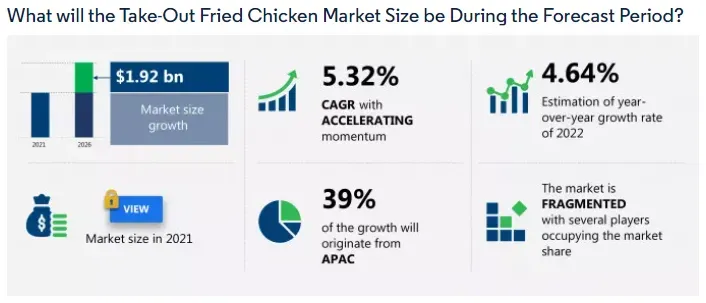
According to a recent report from Technavio.com , the fried chicken market is expected to expand by USD 1.92 billion and grow at a CAGR of 5.32% from 2021 to 2026.
Nearly 40% of this growth is anticipated to come from the APAC region during the forecast period, making it the region that will contribute the most.
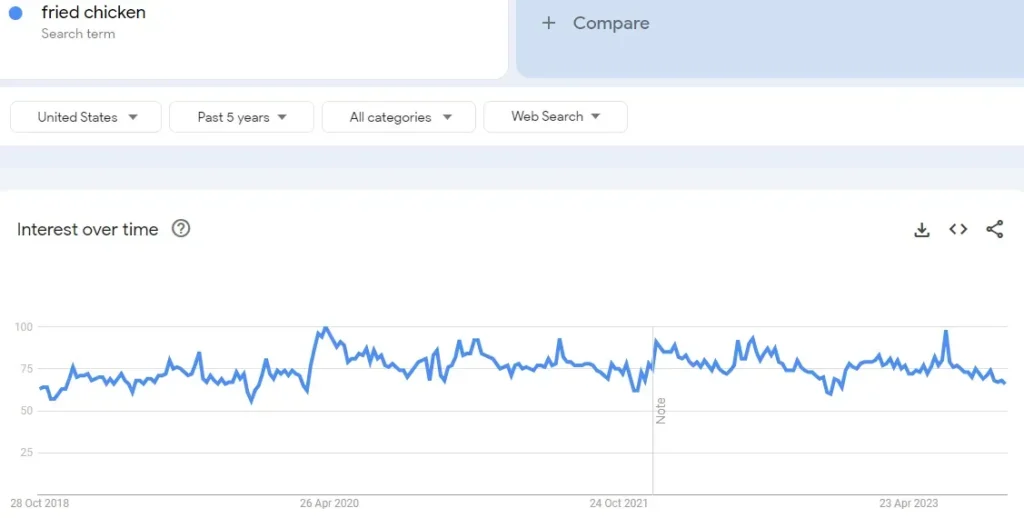
The image shows the trend of the search term “fried chicken” over the last 5 years. The trend shows steady and slow growth over time.
Consider the pros and cons :
- High demand
- Good profit margins
- Versatility Food Item
- Branding potential
- Scalability and growth
- Growing food sector
- Repeat customers
- Low startup cost
- Start from your city
- Intense competition
- Operational challenges
- Staffing and training
- Equipment and maintenance
Analyzing the market growth, pros and cons, makes it easy to understand the profitability.
Fried chicken profit margin:
The profit margin of fried chicken is not similar everywhere; it depends on location, demand, competition, business model, cost of chicken in this area, seasons, and others. Still, you will get a good profit margin.
You can research and explore potential sources to know the profit margin.
How to start a fried chicken business?

Starting a fried chicken shop is not difficult, but you need proper resources, a business plan, business capital, and a brief understanding of market demand and competition.
Understand the target market and potential customer base, and build your successful business.
However, you should choose a high-potential location with more foot traffic.
Here, we covered all the steps in this post.
Decide shop model Write a business plan Find a suitable location Calculate your startup cost Prepare business funds Learn fried chicken preparation Obtain license and permits Promote your shop Partner with food delivery services Create a professional website Hire staff and employees
Follow the given process to set up your venture successfully.
Step 1. Decide on an independent or franchise shop
To establish a successful venture, acquire the necessary information, prepare an effective action plan, and heed experts’ advice.
To start, one needs to set up one’s physical establishment like a restaurant or store; this is an independent shop; another is by taking a franchise to open a shop.
You can also start with other business models; no matter which one you choose, you should always focus on quality and good customer service.
Here are other fried chicken business ideas you can consider.
- Restaurant or shop
- Delivery service
- Catering service
- Franchise resturant model
There is no straightforward answer to this query – “Should I start a franchise or independent shop?” It depends on your planning, budget, goal, location, and other factors.
However, here are some points (pros and cons) you can consider.
Independent fried chicken shop
If you want to establish your brand, consider opening a local shop. While risks are involved, you also have the opportunity to invest in a way that reflects your preferences.
Pros and cons of opening your shop:
- Flexibility in menu and branding.
- Complete control over business decisions.
- Higher profit potential as you retain all earnings.
- Ability to customize operations to the local market.
- Opportunity to build a unique brand and loyal customer base.
- Higher initial investment
- Need to establish brand reputation from scratch.
- Market research, recipe development, and operations setup.
- Limited support compared to a franchise.
- Marketing and advertising
The basic requirement:
- Business plan and funding
- Need licenses and permits
- Location selection and lease/rental
- Good location, where more target customers
- Need to buy equipment and supplies
- Menu development and recipe testing
- Hiring and training staff
- Marketing, promotion, and branding
- All the requirement is your responsibility
Franchise shop
In franchising, they have to open a shop under another established brand name and follow the recipe and quality guidelines given by them.
That is why the company trains you.
Buying a franchise may be the right decision if you are risk-averse and have a significant amount of capital.
Pros and cons of the franchise business model:
- Established brand recognition and customer base.
- Proven business model and operational processes.
- Training and support from the franchisor.
- Access to marketing materials and national/regional advertising.
- Assistance with site selection and lease negotiations.
- Initial franchise fee and ongoing royalty payments.
- Less flexibility in menu and branding decisions.
- Limited control over business operations and policies.
- Potential competition from other franchisees.
- There is less room for customization and local market adaptation.
Basic requirement:
- Research and selection of a suitable franchise.
- Agreement negotiation and signing.
- Payment of franchise fees and royalties.
- Training and compliance with the franchisor’s operational guidelines.
- Location selection and lease/rental agreements.
- Staff hiring and training.
- Marketing and advertising strategies Support.
- Ongoing communication and collaboration with the franchisor.
Best fried chicken franchise:
If you want to start with a franchise business model, consider the given franchise brand as others, depending on your research, budget, and location.
The given information is based on our research, so if you want to access more about every particular brand, visit their official franchise page.
Step 2. Write A fried chicken business plan

Before taking any action, the step is writing a proper plan for your business. We also tell beginners to write a plan, but it can be difficult without knowing the process.
First, know why a business plan is important; a business plan helps to reach goals and objectives. Also provides a road map for making strategies, plans, and other activities.
Focusing on your vision, target, and goal, write down those ideas in a notebook or spreadsheet.
Those outlines help in your business action and are also important for success.
Follow the given steps to create a well-written business plan.
- Write a summary of the business: Target market, business location, funding, startup cost, marketing plan, team building, etc.
- Create a business description: Your product type, menu, target, goals, customer service, pricing, etc.
- SWOT analysis: Conduct a SWOT analysis – strengths, weaknesses, opportunities, and threats.
- Business model: Decide your business model (online delivery, restaurant, food truck, or catering service).
- Research the market: Fried chicken trend in your area, research demographically, competition and competitors, etc.
- Products and services: Description of your fried chicken menu, unique selling proposition, best taste, and quality ingredients.
- Marketing and Sales Strategy: Prepare to promote your food service through online and offline marketing channels.
- Operational Plan: You must select a high foot traffic location, require equipment and supplies, find a good supplier, staffing, and other ongoing plans.
- Financing and funding request: Your expenses, revenue, and profit margin, and try to get funding from different sources to grow your business as a brand.
Step 3. Find a suitable location for your shop

After preparing your business plan, find a good location to open your shop where you can get more potential customers.
Many people face difficulties finding a good location, but Your street and city are the best options for opening a food-based shop.
I hope you are familiar with your city to easily determine whether this place is good before selecting a spot.
From finding the proper city to choosing a spot with good foot traffic, parking area, near a shipping mall, and schools, many factors must be considered.
With careful research and analysis, identify the best location for your business, which will be part of your success.
Below, you can consider the points for choosing an ideal location:
- Choose a place where there are a lot of people.
- Make sure the customer is easy to reach.
- Consider the area’s population and if they would be interested in fried Chicken.
- Find a location with fewer competing fried chicken shops nearby.
- Make sure there is enough parking space nearby.
- Find a visible location where people can easily see your store.
- Ensure enough space for your kitchen and seating (if applicable).
- Choose a place that suits your budget for rent or lease.
- Follow local laws and obtain necessary permits.
- Check if utilities like electricity and water are available.
Step 4. Plan and calculate the startup cost

It would help if you calculated the business’s initial startup cost with ongoing expenses; depending on your operational plan and business size, the expenses can be high or low.
Calculating the expenses is not straightforward for the average startup cost for a fried chicken business.
Such expenses needed:
- A commercial space (rent or purchase)
- Buy kitchen equipment and supplies.
- Furniture, tables, chairs, signage, etc.
- Inventory (Chicken, cooking oil, and spices).
- Licenses and permits
Ongoing expenses:
You must create a budget for ongoing expenses to run a successful fried chicken business.
- Rent or mortgage payments
- Utilities (electricity, gas, water, etc.)
- Inventory (Chicken, cooking oil, spices, etc.)
- Maintenance and repairs
The overall startup cost may be around ($10,000-$20,000) on average.
Purchase equipment and supplies
Next, buy equipment, supplies, and ingredients for making fried chicken.
Find the best supplier in the market to buy fresh Chicken or ingredients, and for buying the equipment, check online stores like Amazon and Alibaba.
Fried chicken restaurant equipment list :
- Commercial deep fryer
- Coolers and freezers
Breading pans
- Cooking utensils: tongs, spatulas, oven, etc.
- Food thermometer
- Storage containers
- Safety equipment
- Cleaning supplies
- Other cooking equipment
- Furniture and table
- Serving and packaging equipment

Cooking utensils

Fried chicken ingredients :
- Good quality chicken
- Salt and pepper
- Different types of sauce
Research buying all those supplies and equipment from a reputed supplier; you can buy kitchen equipment from online stores (Amazon, eBay, Alibaba, Walmart, and Alliexpress).
A good supplier connection is a must for buying fresh ingredients (chicken), so keep the point in mind.
Step 5. Prepare fried chicken business capital
Significant investment will be required to start, which will have to be prepared in advance to open a shop; the most crucial requirements are:
- Commercial space
- Equipment and supplies
- Inventory cost
- Marketing expenses
Prepare the capital according to the business plan; it depends on how much you want to invest in this startup, your specific goals, and your needs.
Create a detailed list of your startup costs after preparing the finance from different mediums, personal savings, and business loans, and ask your families and friends for help.
Step 6. Learn how to make fried chicken for selling
Making fried Chicken is an easy process; with some simple steps, you can make crispy Chicken using some ingredients and pieces of Chicken.
Making delicious fried chicken requires marinating all ingredients in the right quantity and with different flavorings.
To learn the proper making process, connect with professionals, follow YouTube tutorials, and also you can take online cooking classes.
Hire a professional chef and staff if you plan to start a medium-scale shop.
Depending on shop size or operation, hire skilled staff accordingly.
Requirements:
- High-quality ingredient
- Fresh chicken
- Oil, spices
A few simple steps:
- 1: Prepare the chicken
- 2: Marinate the chicken
- 3: Fry the chicken in oil
- 4: Serve your customers
Step 7. Obtain a business license, permit, and insurance
Choose a business structure/entity type to register your business. It is important to consider the local, state, or federal laws.
Complete the business registration process and select the best entity (sole proprietorship, LLC, partnership, or corporation).
LLC can be a better option for your food-based shop, it is recommended to consult with your local legal advisor for assistance. For detailed information, check out the ( small business administration ) website.
License and permits:
Also, obtain the necessary licenses and permits to run a food-based restaurant.
Although, here is the information about basic legal requirements.
Expert guidance is still necessary; contact the local authority for this matter.
Depending on your location and business operation, a food license, zoning permit, food handler’s permit, and other requirements may be required.
- Business License
- Food service permit
- Health department permit
- Fire safety permit
- Building permit
- Signage Permit
- Liquor license (if applicable)
- Employee Identification Number (EIN)
- Seller’s Permit
- Zoning permit
- Health and safety inspections
Get business Insurance:
Business insurance is crucial for every business owner to protect their finance and assets from unexpected events that help them to recover from major losses.
Insurance can provide many types of facility- Losses, including property damage, equipment breakdowns, natural disasters, and liability claims.
- General liability insurance
- Business Insurance
- For equipment and machine
- Workers Compensation
Step 8. Promote your fried chicken business
Marketing and promotion is the primary part of business success and growth. Create a well-researched marketing strategy to create a good customer base of fried chicken lovers.
Fried Chicken is the most popular food for people of all ages, so finding target customers may be easy, but the difficulty is market competition.
Here are some simple strategies for promoting fried chicken business that can help to reach more customers and increase sales initially.
There are many marketing methods that you can try; the most effective methods are social media marketing and local promotion for a physical shop.
Using social media like Twitter, Instagram, Facebook, and YouTube reels and videos to build an online user base that helps with business branding and marketing.
- Create a strong online presence.
- Partner with local shops
- Involved in the local community
Next Is to create a traditional marketing plan for promoting your fried Chicken, including (print advertising, television ads, outdoor promotion, etc).
Also, word-of-mouth marketing, banner ads, newspaper ads, and some printing media marketing are useful for your venture; implement all as you want.
Step 9. Partner with online ordering services

In the digital age, everyone is looking to order delicious food online.
Partnering with an online food delivery service is an opportunity to expand your reach and attract a large customer base online.
Which will also help to increase your sales; here are some points you can follow:
- Find the best online food delivery platform
- Contract and build a partnership with them
- Provide the important details (menu options, pricing, location, delivery charges, etc).
- Follow the terms of online food delivery services
- Negotiate commission rate, delivery fees, and other terms
- Understand the online delivery model and promote your services to potential customers
Best online food ordering services:
Step 10. Create a professional website
A website that creates an online presence is also helpful for branding and promotion.
With this website, you can engage your audience and provide them with information about the business, including menu items, prices, operating hours, location, and contact details so that they will come to your shop.
As well as, having a website can help to represent your business as a brand’s personality, value, and unique selling points through visual design, imagery, and content.
Steps of creating a website:
- 1. Choose a domain name
- 2. Buy the best hosting
- 3. Set up Your Website
- 4. Create essential pages
- 5. Start creating content
- 6. Promote your website
Here are some tips for creating a user-friendly website:
- Make sure your website is mobile-friendly.
- Create engaging and high-quality content.
- Add your service and food details.
- Menu and pricing should be added.
- Use high-quality images and videos.
- Keep your website updated.
- You need to add your content information
- As well as include your social channels
A website can facilitate online ordering and payment, making it more convenient for customers to place orders and increase sales.
Also, for targeting the local area, a website can help to improve search engine optimization for (Google My Business), which makes it easier for customers to find a business online and increase its visibility.
Choose a business name :
Choose a business name for your fried chicken business that is essential for creating your branding and identity in the market.
Also, for creating a website, the business name is required; that’s why brainstorm a good name for your business (the name should be – memorable, creative, easy to remember, unique, related to fried Chicken, and simple).
Step 11. Hire staff and employees
The final step for this business is: You need to create a powerful, skilled staff to manage your business properly, which will help in building a successful brand.
Also, teamwork motivates you, and it will help you in many tasks, such as operations management, food preparation, customer service, marketing, accounting, etc.
So you have to hire employees with the right skills and qualities to provide good customer service.
Your responsibility is also to work as a team leader and provide proper training as their roles in this business.
Job roles in a fried chicken shop:
- Customer service representative
- Food preparation worker
- General manager
- Shift Supervisor
Please provide them with clear roles and responsibilities, set performance goals, and communicate effectively to ensure everyone is aligned with the business objectives.
Regular feedback and ongoing training can help the team to continually improve and adapt to changing market conditions.
How to successfully run a fried chicken business
You need certain skills to run a business successfully, so you have the right and proper marketing strategies.
Also, you need to learn different skills (marketing skills, communication skills, business management skills, etc.) to run a fried chicken shop properly.
- Create proper menu
- Provide good customer service
- Hire workforce and employees
- Manage your expenses
- Improve your marketing strategy and product quality
Software and tools can be essential for a fried chicken business to streamline operations, manage inventory, monitor sales, track customer orders, optimize kitchen workflows, and provide valuable data insights to improve business performance.
FAQs (frequently asked questions)
Check out the frequently asked questions and their answer in short.
Let’s check them.
How much does it cost to start a chicken restaurant?
There is no straightforward answer, but we can hint at the startup cost. It may cost around $10,000 to $20,000, depending on your planning, budget, operation size, and location.
How do we promote the fried chicken business?
For promoting any new business, the most effective way is social media (Facebook, Pinterest, Instagram reals, etc.); with this, you can create a website for marketing.
What equipment do you need to fry chicken?
Need some basic equipment such as a deep fryer, oven, fire suppression system, tongs, spatulas, and some safety kits.
How do I open a fried chicken store?
To open a fried chicken store, you must secure financing, select a prime location, create a menu, purchase equipment and supplies, hire staff, obtain necessary licenses and permits, and promote your business through marketing and advertising.
What do you need for profitable Fried chicken?
You need high-quality ingredients, a unique recipe, efficient operations, good pricing, proper customer service, and an effective marketing strategy.
Is fried chicken a good business?
Yes, fried chicken can be a good business if it is executed well and focuses on quality, unique offerings, location, and effective marketing.
How much does it cost to make a fried chicken?
The cost of fried chicken depends on ingredients, chicken type, and oil; generally, $2-$3 (per pound) is required to make fried chicken.
Chicken: $1-2 per serving Breading: $0.25-$0.50 per serving Oil: $0.25-$0.50 per serving Spices: $0.25-$0.50 per serving
Total: $2-3 per serving
Final thought
Fried chicken has a huge consumer base, which is also your target customer. If you want to start this business, it can be profitable in 2024 and upcoming years.
As the competition and challenges are increasing in all the business sectors, in the same way, there is a lot of opportunity arising.
Hopefully, you learned something from this guide about the frying chicken business; if you have any doubts, you can comment below.
You may also like; Start a chicken wing business. How to start a brownie business. How to start a cheesecake business. Start an empanada business.

How to Start a Body Scrub Business? 2024 Learn the Steps

How to Become a Tooth Gem Technician? Get Certified (2024)

How to Start a Bamboo Clothing Business (2024) Step By Step

How to Start a Abaya Business (2024) A Guide – Simple Process

Top 13 Hair Accessories Business Ideas [Sell, Plan, Start] 2024

How To Start A Boat Dealership Business (2024) Guide
Leave a comment cancel reply.
Save my name, email, and website in this browser for the next time I comment.
404 Not found

how to start a fried chicken business
Introduction.
The fried chicken industry has long been a staple in the food business, attracting millions of customers worldwide with its deliciously crispy and flavorful offerings. If you have a passion for cooking and an entrepreneurial spirit, starting your own fried chicken business can be an exciting and rewarding venture. However, embarking on this journey requires careful planning, preparation, and understanding of the industry’s dynamics.
Overview of the Fried Chicken Industry
The fried chicken industry is a thriving sector within the broader food industry, with a global market value projected to reach billions of dollars in the coming years. Fried chicken has become a beloved comfort food, enjoyed by people of all ages and backgrounds. From fast-food chains and casual dining restaurants to food trucks and pop-up stalls, fried chicken establishments cater to a wide range of customers, offering various styles, flavors, and accompaniments.
Why Start a Fried Chicken Business?
Starting a fried chicken business offers numerous advantages and opportunities for aspiring entrepreneurs. Firstly, the demand for fried chicken remains consistently high, making it a lucrative and resilient business venture. Additionally, the industry allows for creative freedom, as you can experiment with different recipes, flavors, and cooking techniques to develop a unique selling point. Moreover, the potential for growth and expansion is vast, with opportunities to diversify your menu, explore new locations, and even franchise your brand.
Key Factors for Success in the Fried Chicken Business
While the idea of running a fried chicken business may be enticing, it is essential to understand the critical factors that contribute to success in this competitive industry. One of the key factors is maintaining high-quality food consistently. Customers expect crispy and flavorful chicken that keeps them coming back for more. Another vital aspect is providing excellent customer service, creating a positive and memorable experience for every patron. Additionally, effective marketing strategies, efficient operations, and staying up-to-date with industry trends are crucial elements that can drive your business towards success.
Legal and Regulatory Considerations
Before diving into the world of fried chicken entrepreneurship, it is important to familiarize yourself with the legal and regulatory requirements specific to the food industry. Different countries and regions have varying regulations governing food establishments, including licensing, permits, health and safety standards, and food handling practices. It is crucial to thoroughly research and comply with these regulations to ensure the smooth operation of your business and maintain the trust and satisfaction of your customers.
Market Analysis and Competition Research
Conducting a comprehensive market analysis and competition research is paramount to understanding the landscape in which your fried chicken business will operate. Analyzing market trends, consumer preferences, and local demographics will help you identify your target market and tailor your offerings accordingly. Furthermore, studying your competition will provide valuable insights into their strengths, weaknesses, and unique selling points, allowing you to differentiate your business and develop strategies to attract and retain customers.
Now that we have explored the overview of the fried chicken industry, the reasons to start a fried chicken business, the key factors for success, legal considerations, and the importance of market analysis and competition research, we can delve into the planning and preparation phase of establishing your own fried chicken business.
Section 0: Getting Started
Starting a fried chicken business requires careful planning and preparation to set a solid foundation for success. This section will guide you through the initial steps and considerations you need to take before diving into the world of crispy, mouthwatering fried chicken.
Defining Your Business Concept and Target Market
The first step in starting any business is to define your concept and identify your target market. Consider what sets your fried chicken business apart from the competition. Are you focusing on a specific regional style of fried chicken, or do you plan to offer a unique twist on traditional recipes? Understanding your concept will help you create a brand identity and attract your ideal customers.
To identify your target market, conduct market research to gain insights into the demographics, preferences, and behaviors of potential customers. Analyze the local area where you plan to establish your business, taking into account factors such as population density, income levels, and existing competitors. This information will help you tailor your offerings and marketing strategies to appeal to your target audience effectively.
Conducting a Feasibility Study
Before investing significant time and resources into your fried chicken business, it is crucial to conduct a feasibility study. This study will assess the viability of your business idea and help you make informed decisions based on market demand, competition, and financial projections.
A comprehensive feasibility study should include a detailed analysis of the market, including the size, growth potential, and trends of the fried chicken industry. Evaluate the competition, both direct and indirect, to understand the level of saturation and identify gaps or opportunities in the market. Additionally, analyze the costs involved in setting up and operating your business, including equipment, ingredients, labor, rent, utilities, and marketing expenses. This analysis will help you determine the feasibility of your business idea and guide your financial planning.
Creating a Business Plan
A well-thought-out business plan is a roadmap that outlines your goals, strategies, and financial projections for your fried chicken business. It serves as a guide for you and potential investors, providing a comprehensive overview of your business and its potential for success.
Your business plan should include sections such as an executive summary, company overview, market analysis, competitive analysis, marketing and sales strategies, operational plan, organizational structure, and financial projections. Each section should be thoroughly researched and clearly articulated to demonstrate your understanding of the industry and your ability to execute your business concept.
Securing Funding and Financial Considerations
Starting a fried chicken business requires capital to cover various expenses, including equipment, inventory, marketing, and initial operating costs. Assess your financial situation and determine how much funding you need to launch your business successfully.
Explore different funding options, such as personal savings, loans from financial institutions, investments from partners or investors, or government grants. Prepare a detailed financial plan that includes start-up costs, projected revenue, and expenses for at least the first year of operation. This will not only help you secure funding but also provide a clear understanding of your business’s financial feasibility and potential profitability.
Choosing the Right Location
The location of your fried chicken business can greatly impact its success. Consider factors such as foot traffic, visibility, accessibility, parking availability, and proximity to your target market. Look for areas with a high volume of potential customers, such as commercial districts, shopping centers, or near colleges or office complexes.
Evaluate the cost of rent or lease agreements, taking into account your budget and projected revenue. Analyze the local zoning regulations and ensure your business complies with any restrictions or requirements. Additionally, assess the infrastructure of the location, including utilities, ventilation, and waste disposal facilities, as these are essential for the smooth operation of your kitchen.
Obtaining Necessary Permits and Licenses
Compliance with legal and regulatory requirements is essential for the smooth and lawful operation of your fried chicken business. Research the permits and licenses required in your jurisdiction, which may include food handling permits, health department certifications, business licenses, and fire safety inspections. Ensure that you have all the necessary documentation and meet the relevant standards before opening your doors to the public.
By following these initial steps of defining your business concept, conducting a feasibility study, creating a business plan, securing funding, choosing the right location, and obtaining necessary permits and licenses, you will lay a solid foundation for your fried chicken business. Once these crucial aspects are in place, you can move forward to the next phase of setting up your kitchen, sourcing ingredients, and hiring and training staff.
Section 1: Planning and Preparation
Once you have laid the groundwork for your fried chicken business, it’s time to move into the planning and preparation phase. This section will guide you through the essential steps and considerations to ensure a smooth and successful launch of your business.
Building upon the initial concept and target market analysis, it is crucial to further define and refine your business concept. Determine the unique selling points that will set your fried chicken business apart from the competition. Consider factors such as the flavor profile, cooking techniques, menu variety, and any special offerings or promotions that will attract customers.
Additionally, understanding your target market in more depth will help you tailor your menu, branding, and marketing strategies to resonate with your ideal customers. Consider their preferences, dietary restrictions, and cultural influences to create a menu that appeals to a wide range of tastes while still maintaining your brand identity.
While you may have conducted a feasibility study in the initial stages, revisiting and updating it during the planning phase is essential. Analyze the current market trends, consumer demands, and competition to ensure that your business concept and projected financials align with the current landscape.
Consider the potential challenges and risks your business may face, such as changing consumer preferences, fluctuating ingredient costs, or unexpected market disruptions. Anticipating and addressing these challenges in your feasibility study will help you develop contingency plans and mitigate potential risks.
Building upon the initial business plan, it’s time to dive deeper into the specifics of your fried chicken business. Start by outlining your mission statement, vision, and core values, which will guide your decision-making and overall business direction.
Continue with a detailed market analysis, assessing the demand for fried chicken in your target market, the competition’s strengths and weaknesses, and any emerging trends or opportunities. Develop a marketing strategy that outlines how you will promote your business, attract customers, and build brand awareness.
Next, focus on your operational plan, detailing the day-to-day operations of your business, including the kitchen workflow, staffing requirements, and inventory management. Consider factors such as sourcing ingredients, supplier relationships, food safety protocols, and quality control measures.
Within your business plan, it’s essential to develop a comprehensive financial plan that includes revenue projections, expense forecasts, and a break-even analysis. This will help you understand the financial viability of your business and secure the necessary funding.
With a detailed financial plan in place, you can now explore various funding options to support your fried chicken business. Start by assessing your personal finances and determine how much capital you can contribute to the business. This self-investment not only demonstrates your commitment but also increases your credibility when seeking external funding.
Consider approaching banks, credit unions, or other financial institutions to inquire about small business loans. Prepare a strong business case, including your business plan, financial projections, and any collateral you can offer to secure the loan. Alternatively, you may seek investors or partners who are willing to provide capital in exchange for equity or a share of the profits.
In addition to securing funding, it is crucial to establish a robust financial management system. Implement accounting software to track your income and expenses accurately, set up a cash flow management system, and regularly review your financial statements. This will enable you to make informed decisions, identify areas for improvement, and ensure the financial health and sustainability of your business.
Selecting the optimal location for your fried chicken business can significantly impact its success. Consider factors such as visibility, accessibility, foot traffic, parking availability, and proximity to your target market.
If you plan to have a dine-in option, evaluate the space requirements, interior layout, and ambiance that align with your brand and customer preferences. If you are focusing on takeout or delivery, prioritize a location that allows for easy access and efficient order fulfillment.
Research the rental or lease options available in your desired area, weighing the costs against the potential revenue. Negotiate lease terms that accommodate your budget and provide flexibility for future growth or changes.
Before opening your fried chicken business, ensure that you have obtained all the necessary permits and licenses required by your local regulatory authorities. The requirements can vary depending on your location, but typically include food handling permits, health department certifications, business licenses, and fire safety inspections.
Contact your local health department or regulatory agency to understand the specific requirements and guidelines you need to follow. It is essential to maintain compliance with these regulations to protect the well-being of your customers, preserve your reputation, and avoid potential legal issues or fines.
By thoroughly planning and preparing for your fried chicken business, you will set yourself up for success. Defining your business concept and target market, conducting a feasibility study, creating a comprehensive business plan, securing funding, choosing the right location, and obtaining the necessary permits and licenses are crucial steps in the journey. With these foundations in place, you can now move forward with setting up your kitchen, sourcing high-quality ingredients, and hiring and training your staff to deliver exceptional fried chicken to your eager customers.
Section 2: Setting Up Your Fried Chicken Business
Now that you have completed the planning and preparation phase, it’s time to move into the practical aspect of setting up your fried chicken business. This section will guide you through the essential steps and considerations to ensure a smooth and efficient setup process.
Choosing the Right Equipment and Supplies
Selecting the appropriate equipment and supplies is crucial for the success of your fried chicken business. Invest in high-quality equipment that can handle the demands of a commercial kitchen and ensure consistent cooking results. Some key equipment to consider includes fryers, grills, ovens, refrigeration units, food processors, and preparation stations.
When choosing equipment, consider factors such as capacity, energy efficiency, ease of maintenance, and warranty options. Research reputable suppliers and compare prices to ensure you get the best value for your investment. Additionally, stock up on essential supplies such as utensils, cookware, food storage containers, packaging materials, and cleaning supplies to support your daily operations.
Setting Up a Functional Kitchen Layout
Efficient kitchen layout and workflow are crucial for maximizing productivity and minimizing the risk of accidents or errors. Consider the different stages of food preparation, from receiving and storing ingredients to cooking and packaging the final product.
Designate specific workstations for different tasks, such as ingredient preparation, breading, frying, and plating. Ensure that the layout promotes a smooth flow of ingredients and minimizes unnecessary movement. Position equipment strategically to optimize space utilization and create designated areas for food safety practices, such as separate zones for raw and cooked ingredients.
Collaborate with kitchen designers or consultants who specialize in commercial kitchen layouts to ensure your kitchen is designed for optimal functionality and compliance with local health and safety regulations.
Sourcing High-Quality Ingredients
To deliver consistently delicious fried chicken, sourcing high-quality ingredients is essential. Identify reputable suppliers who can provide fresh, high-grade chicken, as well as other ingredients such as flour, spices, oils, and breading mixes. Consider working directly with local farmers or poultry suppliers to ensure the quality and traceability of your chicken.
When selecting suppliers, evaluate their reliability, consistency, and adherence to food safety standards. Build strong relationships with your suppliers to negotiate favorable terms, secure competitive pricing, and ensure a steady supply chain. Regularly assess the quality of ingredients received and make adjustments as necessary to maintain the highest standards of taste and freshness.
Hiring and Training Staff
Building a skilled and dedicated team is crucial for the success of your fried chicken business. Start by identifying the key roles and responsibilities required to run your operation smoothly. This may include kitchen staff, cashiers, servers (if applicable), and managerial positions.
When hiring, look for individuals who are passionate about food, have experience in the foodservice industry, and demonstrate a strong work ethic. Conduct thorough interviews, check references, and consider implementing a trial period to assess their skills and fit within your team.
Invest in comprehensive training programs to ensure consistency in food preparation, cooking techniques, and customer service. Train your staff on hygiene and food safety practices to maintain a clean and safe working environment. Foster a positive and supportive work culture that encourages open communication, continuous learning, and growth opportunities.
Developing a Comprehensive Menu
Your menu is the heart of your fried chicken business, so take the time to develop a comprehensive and enticing selection of offerings. Consider your target market, their preferences, and any regional or cultural influences that can inspire unique flavors or menu items.
Offer a variety of options to cater to different dietary preferences and restrictions, such as gluten-free, vegetarian, or spicy alternatives. Experiment with different marinades, breading styles, and seasonings to create signature dishes that set your fried chicken apart from the competition.
Consider complementing your fried chicken with a range of sides, sauces, and beverages to provide a complete dining experience. Regularly review and update your menu based on customer feedback, seasonal availability of ingredients, and emerging food trends.
Establishing Food Safety Protocols and Standards
Maintaining strict food safety protocols is paramount in the foodservice industry, and your fried chicken business is no exception. Develop and implement comprehensive food safety policies and procedures to protect the health and well-being of your customers, as well as to comply with local regulations.
Train your staff on proper food handling, storage, and preparation techniques. Emphasize the importance of personal hygiene, including handwashing, wearing appropriate protective gear, and minimizing cross-contamination risks. Regularly conduct internal audits and inspections to ensure compliance and identify areas for improvement.
Invest in regular equipment maintenance and cleaning schedules to prevent foodborne illnesses and maintain the longevity of your kitchen equipment. Establish temperature monitoring systems to ensure that food is stored and cooked at safe temperatures.
By paying attention to the details of setting up your fried chicken business, such as choosing the right equipment and supplies, designing a functional kitchen layout, sourcing high-quality ingredients, hiring and training staff, developing a comprehensive menu, and establishing food safety protocols and standards, you are setting yourself up for success. These critical steps will create a solid foundation for your operations and ensure that you can consistently deliver delicious fried chicken to your customers.
Section 3: Marketing and Promotion
After setting up your fried chicken business, it’s time to focus on marketing and promoting your brand to attract customers and build a loyal customer base. This section will explore various strategies and tactics to help you effectively market your business and increase its visibility.
Developing a Strong Brand Identity
A strong brand identity is crucial for standing out in a competitive market. Define your brand’s personality, values, and mission to create a unique identity that resonates with your target audience. Consider elements such as your brand name, logo, color scheme, and overall visual aesthetic.
Craft a compelling brand story that communicates the essence of your fried chicken business. Highlight what sets you apart from the competition, whether it’s your secret family recipe, commitment to using locally sourced ingredients, or a specific cooking technique that creates an unmatched flavor profile.
Consistency is key in establishing your brand identity. Ensure that your brand elements are consistently applied across all touchpoints, including your signage, packaging, website, social media profiles, and marketing materials. This consistency will help customers recognize and remember your brand, fostering a sense of trust and familiarity.
Creating an Effective Marketing Strategy
A well-rounded marketing strategy will help you reach your target market and generate awareness and interest in your fried chicken business. Start by identifying your marketing goals, whether it’s increasing foot traffic, boosting online orders, or expanding your customer base.
Segment your target market based on demographics, preferences, and behaviors to tailor your marketing efforts effectively. This will allow you to create targeted messaging and select the most appropriate marketing channels to reach your desired audience.
Consider a mix of both traditional and digital marketing tactics. Traditional methods may include local print advertisements, radio spots, or even sponsoring community events. Digital marketing avenues include social media marketing, search engine optimization (SEO), pay-per-click advertising, email marketing, and influencer collaborations.
Utilizing Digital Marketing Channels
Digital marketing channels offer cost-effective and highly targeted options to reach your audience. Establish a strong online presence by creating a user-friendly website that showcases your menu, location, contact information, and customer testimonials.
Leverage social media platforms to engage with your audience and build a community around your brand. Regularly post mouthwatering images of your fried chicken, share behind-the-scenes content, and run promotions or contests to encourage user-generated content and word-of-mouth marketing.
Invest in search engine optimization (SEO) to improve your website’s visibility in search engine results. Research relevant keywords and optimize your website’s content, meta tags, and headings accordingly. Consider creating a blog section on your website to share recipes, cooking tips, and stories related to fried chicken, establishing yourself as an authority in the industry.
Implementing Traditional Marketing Tactics
While digital marketing is essential, don’t overlook the power of traditional marketing tactics to reach a wider audience. Advertise in local newspapers, distribute flyers or brochures in high-traffic areas, and partner with local businesses to cross-promote each other.
Consider hosting community events or participating in food festivals to showcase your fried chicken and introduce your brand to a larger audience. Sponsor local sports teams or charitable events to increase brand visibility and demonstrate your commitment to the community.
Word-of-mouth marketing remains a powerful tool for generating buzz and attracting new customers. Provide an exceptional dining experience, encourage customer reviews and referrals, and consider implementing a loyalty program to reward and retain your existing customers.
Building Customer Loyalty and Retention Programs
Fostering customer loyalty is essential for the long-term success of your fried chicken business. Implement customer loyalty programs to reward repeat visits and encourage customer retention. This can include offering discounts, freebies, or exclusive promotions to your loyal customers.
Invest in providing exceptional customer service to create a memorable experience for every customer. Train your staff to be friendly, knowledgeable, and attentive to customer needs. Encourage feedback and actively listen to customer suggestions or concerns to continuously improve your offerings and service.
Regularly communicate with your customer base through email marketing campaigns or SMS notifications. Keep them informed about new menu items, special promotions, or upcoming events. Personalize your communications based on their preferences and purchase history to create a more personalized and engaging experience.
By developing a strong brand identity, creating an effective marketing strategy, utilizing digital and traditional marketing channels, implementing customer loyalty and retention programs, and prioritizing exceptional customer service, you will position your fried chicken business for success. Continuously evaluate and adapt your marketing efforts based on customer feedback and market trends to stay ahead of the competition and maintain a strong presence in the industry.
Section 4: Operations and Management
Once your fried chicken business is up and running, it’s essential to focus on efficient operations and effective management to ensure its long-term success. This section will cover key aspects of running your business smoothly and meeting customer expectations.
Managing Inventory and Supply Chain
Efficient inventory management is crucial to maintain a steady supply of ingredients and minimize waste. Implement an inventory tracking system to monitor ingredient levels and forecast demand accurately. Set par levels for each ingredient to ensure you have enough stock on hand without excess inventory.
Establish relationships with reliable suppliers to ensure a smooth supply chain. Communicate your needs and expectations clearly and regularly review supplier performance. Consider implementing just-in-time inventory management to reduce holding costs and ensure freshness.
Regularly assess your inventory turnover rate and adjust your ordering quantities accordingly. Monitor ingredient quality to maintain the consistency and taste of your fried chicken. Conduct regular inventory audits to identify any discrepancies and address potential issues promptly.
Ensuring Efficient Operations and Workflow
Streamlining your operations and optimizing workflow is essential to maximize productivity and customer satisfaction. Define standardized procedures for each aspect of your operations, from receiving and storing ingredients to cooking, packaging, and serving.
Identify potential bottlenecks in your kitchen and implement strategies to overcome them. Optimize your kitchen layout for efficiency, ensuring that staff can move seamlessly between stations. Train your staff on time management and prioritize tasks based on their urgency and importance.
Utilize technology to automate certain processes and simplify your operations. Invest in a point-of-sale (POS) system to streamline order processing, track sales, and gather valuable data for analysis. Implement kitchen display systems (KDS) to improve communication between the front-of-house and back-of-house staff, reducing errors and wait times.
Regularly evaluate your operations and seek feedback from your staff to identify areas for improvement. Foster a culture of continuous improvement, encouraging staff to propose innovative ideas and solutions to enhance efficiency and customer experience.
Delivering Exceptional Customer Service
Exceptional customer service is fundamental to building a loyal customer base and establishing a positive reputation for your fried chicken business. Train your staff to be friendly, attentive, and responsive to customer needs. Encourage them to go above and beyond to ensure customer satisfaction.
Create a welcoming and comfortable atmosphere in your establishment. Pay attention to the cleanliness and aesthetics of both the dining area and restrooms. Regularly inspect and maintain your facility to provide a pleasant and safe environment for your customers.
Implement strategies to manage customer wait times effectively. Set realistic expectations and communicate estimated wait times clearly. Consider offering pre-ordering options or online ordering platforms to minimize customer wait times during peak hours.
Respond promptly and professionally to customer feedback and complaints. Address any issues or concerns promptly and strive to resolve them to the customer’s satisfaction. Use customer feedback as an opportunity to improve your offerings and processes.
Monitoring and Analyzing Business Performance
Regularly monitoring and analyzing your business performance is essential to make informed decisions and identify areas for improvement. Establish key performance indicators (KPIs) that align with your business goals and track them regularly.
Analyze sales data to identify trends, popular menu items, and peak hours. Use these insights to optimize your menu and pricing strategies. Monitor customer satisfaction through surveys, online reviews, and feedback platforms. Identify patterns or recurring issues and take proactive steps to address them.
Track your financial performance by regularly reviewing your profit and loss statements, balance sheets, and cash flow statements. Compare your actual performance against your projected goals and identify any deviations. Adjust your financial plan and strategies as needed to ensure the long-term financial health of your business.
Utilize technology tools and software to streamline data collection and analysis. Implement data analytics tools to gain deeper insights into your customer base, their preferences, and their purchase patterns. Leverage this information to tailor your marketing efforts and enhance customer experience.
Adapting to Industry Trends and Customer Preferences
The food industry is constantly evolving, with new trends and changing customer preferences. Stay informed about industry trends, emerging flavors, and innovative cooking techniques. Attend industry conferences, participate in workshops, and network with other food entrepreneurs to stay ahead of the curve.
Listen to your customers and adapt your offerings based on their feedback and preferences. Regularly introduce new menu items, seasonal specials, or limited-time promotions to keep your menu exciting and fresh. Experiment with new flavors or fusion concepts to attract adventurous customers.
Stay active on social media platforms and engage with your audience. Monitor online conversations and trends related to fried chicken or the food industry in general. Participate in online discussions and share relevant content to position yourself as a thought leader and keep your brand top of mind.
By effectively managing inventory and supply chain, ensuring efficient operations and workflow, delivering exceptional customer service, monitoring and analyzing business performance, and adapting to industry trends and customer preferences, you will position your fried chicken business for long-term success. Continuously assess and optimize your operations to maintain a competitive edge and exceed customer expectations.
Section 5: Scaling and Expanding Your Fried Chicken Business
Once your fried chicken business is thriving, you may start considering opportunities for growth and expansion. This section will explore strategies and considerations for scaling up your business and exploring new avenues for growth.
Managing Growth and Scaling Strategies
Scaling your fried chicken business requires careful planning and execution to ensure a smooth transition. Assess your current operations, resources, and capacity to determine if you are ready for expansion. Consider factors such as demand, profitability, and the availability of resources, including kitchen space, equipment, and staff.
Develop a growth strategy that aligns with your business goals and market opportunities. This could include opening additional locations, expanding into new markets, or diversifying your offerings. Conduct market research to identify potential locations or target markets that align with your brand and customer base.
Invest in technology and systems that support expansion. Implement centralized management systems that streamline operations across multiple locations. Leverage cloud-based software to manage inventory, sales, and customer data in real-time. This will enable you to maintain control and consistency as you grow.
Ensure that your business processes and standard operating procedures are well-documented and easily replicable. This will facilitate the training and onboarding of new staff as you expand. Focus on staff development and invest in leadership training to ensure that your management team can effectively oversee multiple locations.
Exploring Franchising Opportunities
Franchising can be an effective strategy for expanding your fried chicken business while minimizing the risk and capital investment. Franchising allows you to leverage the entrepreneurial spirit and resources of others to grow your brand.
Before considering franchising, ensure that your business model and operations are well-established and proven. Develop a comprehensive franchise system that includes detailed operations manuals, training programs, and ongoing support for franchisees.
Work with legal and franchise consultants to navigate the legal requirements and develop appropriate franchise agreements. Conduct thorough due diligence on potential franchisees to ensure they align with your brand values and have the necessary resources and experience to operate a successful franchise.
Implement robust franchisee support and communication channels to maintain consistency and ensure that franchisees are properly trained and supported. Regularly evaluate and monitor franchisee performance to ensure brand standards are met and customer satisfaction is maintained.
Diversifying Your Offerings
Diversifying your offerings can be a strategic way to attract new customers and increase revenue streams. Consider expanding your menu to include additional items that complement your fried chicken, such as side dishes, salads, desserts, or beverages.
Explore opportunities for catering services to cater to private events, corporate functions, or parties. Develop catering packages that showcase your fried chicken and other menu items in a format suitable for larger groups.
Consider offering take-home meal kits or frozen fried chicken options for customers who prefer to enjoy your food at home. This can expand your reach beyond your immediate area and cater to customers who may not have the time or inclination to dine out.
Collaborate with other businesses or food trucks for joint promotions or pop-up events. This can help you tap into new customer bases and create exciting experiences that differentiate your brand.
Expanding Your Online Presence
In today’s digital age, expanding your online presence is crucial for reaching a wider audience and driving customer engagement. Enhance your website to facilitate online ordering, reservations, or delivery services. Ensure that your website is mobile-friendly, as an increasing number of customers use their smartphones to search for and order food.
Invest in search engine optimization (SEO) to improve your website’s visibility in search engine results. Research relevant keywords and optimize your website’s content and meta tags accordingly. Regularly update your website with new content, such as blog posts, recipes, or promotions, to keep it fresh and engaging.
Leverage social media platforms to connect with your audience and build a community around your brand. Regularly post enticing food images, behind-the-scenes content, and customer testimonials. Engage with your followers by responding to comments, messages, and reviews. Consider partnering with influencers or running social media contests to increase brand awareness and reach.
Explore online delivery platforms and food aggregator apps to expand your reach and tap into a broader customer base. Partner with these platforms to offer convenient delivery options to customers who prefer to enjoy your fried chicken from the comfort of their homes.
Monitoring Industry Trends and Innovations
Continuously monitoring industry trends and innovations is essential to stay relevant and competitive in the fried chicken business. Attend industry conferences, trade shows, and workshops to stay informed about emerging flavors, cooking techniques, and consumer preferences.
Stay connected with your customers and seek their feedback on new menu items, promotions, or concepts. Conduct surveys or focus groups to gather insights into their evolving preferences and expectations. Use this feedback to adapt your offerings and stay ahead of the competition.
Keep an eye on technological advancements and innovations in the food industry. Explore opportunities to implement automation or robotics in your kitchen to improve efficiency and reduce costs. Stay informed about sustainability practices and consider adopting eco-friendly initiatives to appeal to environmentally conscious customers.
By effectively managing growth and scaling strategies, exploring franchising opportunities, diversifying your offerings, expanding your online presence, and monitoring industry trends and innovations, you can position your fried chicken business for continued growth and success. Continuously assess market opportunities and adapt your strategies to stay ahead of the competition and meet the evolving needs of your customers.
How to Open a Fried Chicken Store
- Small Business
- Setting Up a New Business
- Open a Store
- ')" data-event="social share" data-info="Pinterest" aria-label="Share on Pinterest">
- ')" data-event="social share" data-info="Reddit" aria-label="Share on Reddit">
- ')" data-event="social share" data-info="Flipboard" aria-label="Share on Flipboard">
How to Get a Snack Bar Restaurant Started
How to open a protein smoothie business that's not a franchise, how to start a hawaiian restaurant.
- How to Start a Fresh Juice Business
- How to Have a Shaved Ice Stand
Becoming a successful business owner is the dream of many people. As your own boss, you can work when it suits you and determine your own earnings. The reality is that most small business owners work harder than the average employee, but the owner does have the satisfaction of independence. Opening a store to sell fried chicken meals to your target market will enable you to enjoy the benefits of owning your own business.
Finding an Optimal Location
The first step in opening a fried chicken store is to find a location to rent or buy that will house your store. Location is critically important for a food outlet, which should be located in an area with plenty of pedestrian traffic. This might include a shopping mall or town center, an industrial area where few other food options are available, or near a beach.
Check that the zoning of the premises is suitable for the level of food handling you plan to offer. For example, in Minnesota some premises are zoned for the selling and serving of foods only, while others are zoned for food preparation and cooking.
Licenses and Permits
Businesses involved in activities regulated by government agencies require licensing and permits. If you plan to serve alcohol, for example, with your fried chicken meals you will need an alcoholic beverage license. State and local food laws vary.
In Michigan, for instance, you would need a food establishment license if the food is prepared off site. However, if the fried chicken is prepared on the premises you need a food processing permit, which has specific health requirements.
Business Planning and Finance
To obtain financing for your business, prepare a detailed business plan and budget with which to approach potential investors. Your bank or credit union may be prepared to finance your fried chicken store if your business plan is convincing and includes solid research on the target market and the viability of the operation. Venture capital or angel investors may also be open to receiving proposals. However, you should have all agreements checked by a lawyer before you accept the terms.
Finding Potential Suppliers
To identify suppliers for the purchases you need to make, obtain quotes from the wholesalers and farmers in your region. You need to find sources of raw chicken, spices and cooking products, as well as any other food items you plan to sell as side orders. Visit potential suppliers’ facilities to satisfy yourself of the hygiene and legality of their operations. If your chicken comes from local suppliers, you need to ensure that it carries approval in terms of the USDA’s meat and poultry guidelines and standards.
Finalizing Product Range
To finalize your product range, compile a list of the items you plan to sell. This may include different cuts of fried chicken, and a variety of sauces and recipes for the chicken. You could also include products that you believe will complement the chicken, such as fries, side salads, vegetable dishes and rolls. This will help you identify the equipment you need to prepare the menu items.
Calculate the pricing of your products by researching other food vendors in the area to find out what the common expenditure is in the target market.
Marketing to Potential Customers
Marketing your new fried chicken store to potential customers requires a launch event or special opening, with advertising in the local newspaper. Design and print fliers that you can distribute to homes and businesses in the area, inviting them to sample the chicken. Offer special promotions for the opening week that encourage customers to try out your product.
Serve quality foods and offer excellent customer service, as these factors will ensure the success of your store. Reach out to other local businesses and events, like farmers markets, caterers and meal delivery services, to identify other opportunities for clients and sales.
Create an Online Presence
Bring your new store online, as well. Your presence on the internet can include a webpage, social media services like Facebook, review sites like Yelp and discount services like Groupon. Online ad programs like Google Adsense allow you easily advertise your eatery in response to people searching for fried chicken restaurants in your area. Online ads can be targeted to your local community so you can be sure of reaching potential customers who can easily drop by.
- Minnesota Department of Agriculture: Starting a Food Business in Minnesota
- Michigan.gov: Food Establishment License
- Michigan Business One Stop: Food Establishment License
- Entrepreneur: Take-Out Chicken and Wings
Tracey Sandilands has written professionally since 1990, covering business, home ownership and pets. She holds a professional business management qualification, a bachelor's degree in communications and a diploma in public relations and journalism. Sandilands is the former editor of an international property news portal and an experienced dog breeder and trainer.
Related Articles
How to start a waffle business, how to start a fried dough business, how to start a peanut brittle business, how to start a new frozen yogurt shop, how to start a candy store business, how to start a deli grocery, how to start a burger business, starting up a farm & home store, how to start a non-dairy frozen dessert business, most popular.
- 1 How to Start a Waffle Business
- 2 How to Start a Fried Dough Business
- 3 How to Start a Peanut Brittle Business
- 4 How to Start a New Frozen Yogurt Shop
Fast Food Business Plan Template
Written by Dave Lavinsky
Business Plan Outline
- Fast Food Business Plan Home
- 1. Executive Summary
- 2. Company Overview
- 3. Industry Analysis
- 4. Customer Analysis
- 5. Competitive Analysis
- 6. Marketing Plan
- 7. Operations Plan
- 8. Management Team
- 9. Financial Plan
Fast Food Restaurant Business Plan & Template
You’ve come to the right place to create your fast food business plan.
We have helped over 100,000 entrepreneurs and business owners create business plans and many have used them to start or grow their fast food businesses.
Fast Food Business Plan Example
Below are links to each section of a fast food restaurant business plan sample:
Next Section: Executive Summary >
Fast Food Business Plan FAQs
What is a fast food business plan.
A fast food business plan is a plan to start and/or grow your fast food restaurant. Among other things, it outlines your business concept, identifies your target customers, presents your marketing plan and details your financial projections.
You can easily complete your fast food business plan using our Fast Food Business Plan Template here .
What Are the Main Types of Fast Food Businesses?
There are many types of fast food businesses. The most common fast food restaurants serve hamburgers, fries, and soft drinks. Other common fast food establishments serve chicken, Chinese food, Mexican food, and pizza. There is a recent trend in fast food restaurants serving healthier options such as smoothies, wraps, sandwiches, and salads. A fast food restaurant can be centered around any food genre that is able to be prepared fast and in large quantities to serve multiple customers daily.
What Are the Main Sources of Revenue and Expenses for a Fast Food Restaurant?
The primary source of revenue for a fast food restaurant are the food and drink items sold at the establishment.
The key expenses are the costs to source the ingredients for the menu items, kitchen equipment and supplies, overhead expenses for the staff and rent, and any marketing costs the restaurant chooses to partake in.
What is the Difference Between a Franchise and Non-Franchise Fast Food Restaurant?
A franchise fast food restaurant is a business that is owned and operated by someone who has a contract with a larger company. That company provides the products, training, and marketing for the smaller business. A non-franchise fast food restaurant is a business that is independently owned and operated.
Franchise fast-food restaurants have a set of guidelines and standards to which they must adhere in order to use the franchise name. Non-franchise fast food restaurants do not have these guidelines and can vary greatly in terms of quality, cleanliness, and customer service.
How Do You Get Funding for Your Fast Food Business?
Fast food businesses are most likely to receive funding from banks. Typically you will find a local bank and present your business plan to them. Another option for a fast food business is to obtain a small business loan. SBA loans are a popular option as they offer longer loan terms with lower interest rates. Outside investors, crowdfunding, and/or friends or family are other typical funding options. This is true for a fast casual restaurant business plan or a takeout restaurant business plan.
What are the Steps To Start a Fast Food Business?
Starting a fast food restaurant can be an exciting endeavor. Having a clear roadmap of the steps to start a successful fast food business will help you stay focused on your goals and get started faster.
1. Write A Fast Food Business Plan - The first step in starting a business is to create a detailed fast food business plan that outlines all aspects of the venture. This should include market research on the fast food industry and potential target market size, information on your fast food menu, marketing strategy, pricing strategy and a detailed financial forecast.
2. Choose Your Legal Structure - It's important to select an appropriate legal entity for your fast food business. This could be a limited liability company (LLC), corporation, partnership, or sole proprietorship. Each type has its own benefits and drawbacks so it’s important to do research and choose wisely so that your fast food business is in compliance with local laws.
3. Register Your Fast Food Restaurant - Once you have chosen a legal structure, the next step is to register your fast food business with the government or state where you’re operating from. This includes obtaining licenses and permits as required by federal, state, and local laws.
4. Identify Financing Options - It’s likely that you’ll need some capital to start your fast food business, so take some time to identify what financing options are available such as bank loans, investor funding, grants, or crowdfunding platforms.
5. Choose a Location - Whether you plan on operating out of a physical location or not, you should always have an idea of where you’ll be based should it become necessary in the future as well as what kind of space would be suitable for your operations.
6. Hire Employees - There are several ways to find qualified employees including job boards like LinkedIn or Indeed as well as hiring agencies if needed – depending on what type of employees you need it might also be more effective to reach out directly through networking events.
7. Acquire Necessary Fast Food Equipment & Supplies - In order to start your fast food business, you'll need to purchase all of the necessary equipment and supplies to run a successful operation.
8. Market & Promote Your Business - Once you have all the necessary pieces in place, it’s time to start promoting and marketing your fast food business. Marketing efforts includes creating a website, utilizing social media platforms like Facebook or Twitter, and having an effective Search Engine Optimization (SEO) strategy. You should also consider traditional marketing techniques such as radio or print advertising to reach your target audience.
Where Can I Get a Fast Food Business Plan PDF?
You can download our free fast food business plan template PDF here. This is a sample fast food business plan template you can use in PDF format.

How To Start A Fried Chicken Business
Starting a fried chicken business entails drafting a detailed business plan, conducting market research, securing funding, finding an ideal location, acquiring necessary licenses and permits, sourcing quality chicken, hiring staff, implementing stringent health and safety measures, and effectively marketing your business.
- Last Update: November 23, 2023

- Steps in this Guide: 11
Are you passionate about fried chicken? Do your friends and family rave about your secret recipe? If so, starting a fried chicken business might be the perfect venture for you. With its universal appeal and potential for high profitability, the fried chicken industry continues to thrive, attracting both established chains and independent entrepreneurs. In this blog post, we will guide you through the essential steps to start your own fried chicken business, from creating a tantalizing menu to securing the necessary permits. Whether you’re planning to open a restaurant, food truck, or delivery service, this comprehensive guide will equip you with the knowledge and confidence to succeed in the world of crispy, mouth-watering fried chicken. So, let’s get started on this finger-licking journey!
How To Start A Fried Chicken Business: Step-by-Step
Step 1: market research.
In order to effectively strategize in the fried chicken market, conducting a market study is crucial. This involves analyzing current trends, understanding target customers’ preferences, price sensitivity, and identifying the competition, allowing for informed decision-making and successful differentiation.
Step 2: Create a Business Plan
Based on thorough market research, create a comprehensive business plan. Include the mission and objectives, marketing and sales strategies, as well as financial forecasts to provide a clear roadmap for your business’s success.
Step 3: Find the Perfect Location
When seeking a location for your business, prioritize areas with abundant pedestrian activity, easy accessibility, and prominent visibility among your intended customers. It is equally crucial to consider proximity to your preferred suppliers to guarantee the quality and freshness of the ingredients you use in your offerings.
Step 4: Venture Funding
When starting a fried chicken business, it is crucial to estimate and assess the various expenses involved. To fund the venture, potential options include obtaining a loan, seeking investments from interested individuals, or utilizing personal savings.
Step 5: Legal Requirements
It is crucial to research and understand the specific permits and licenses required to legally operate your business. Each location may have different requirements, which can vary by country, state, or city. Ensure compliance to avoid any legal issues.
Step 6: Develop Your Menu and Pricing
Create a captivating and diverse menu tailored to your target market’s preferences, focusing on an assortment of delicious fried chicken recipes. Ensure competitive pricing that allows for profitability, striking the perfect balance between enticing your customers and maximizing your revenue.
Step 7: Procure Equipment and Hire Personnel
In addition to purchasing all necessary equipment for preparation and sale of products, it is crucial to hire skilled personnel to handle various tasks such as cooking, serving, cleaning, and managing the business effectively.
Step 8: Supplier Partnership
In order to maintain a successful business, it is essential to find trustworthy suppliers who can not only provide high-quality ingredients but also ensure a steady and sufficient supply to meet the demands of the operation.
Step 9: Marketing and Advertising
Develop a strategic marketing plan to attract customers by utilizing various channels such as social media, print advertising, local events, and advertisements on local radio or TV stations. This multi-faceted approach will maximize visibility and effectively engage a diverse range of potential customers.
Step 10: Grand Opening
Plan a successful grand opening event by organizing promotional activities like live music, giveaways, and discounts. This will help attract a larger customer base and create a buzz around your business.
Step 11: Evaluate and Improve
It is crucial to regularly assess business performance in relation to established plans and objectives. This involves evaluating financial outcomes, gathering customer feedback, and monitoring employee performance. To ensure success, adapt and enhance strategies whenever necessary.
Starting a fried chicken business can be a challenging yet rewarding venture. By following the steps detailed in this blog post, you can lay the foundation for a successful enterprise. Remember, thorough market research, a solid business plan, quality ingredients, impeccable customer service, and effective marketing strategies are crucial for achieving long-term success. With dedication, hard work, and a passion for delicious food, you can carve out your niche in the competitive food industry. So gather your recipes, hone your frying skills, and get ready to embark on an exciting journey in the world of fried chicken!

Get our first toolkit for FREE!
Including a detailed step-by-step 📋 guide , a ready to use 📊 template and curated 📚 information .
May 5, 2020
Franchising vs. Starting A Fried Chicken Business From Scratch
Golden Chick
Starting a fried chicken restaurant business is a terrific way to make your living — and we ought to know! We’ve been doing it for over 50 years , and in that time, we’ve learned a thing or two about not only how to cook and serve the best fried chicken in our industry, but also how to operate our restaurants efficiently and successfully.
Table of Contents
So, if you’re someone who’s thinking about starting a fried chicken restaurant business , we can tell you there are two ways to go about that: you can start from scratch and take on all the hard work and responsibilities yourself, or you can partner with a franchise brand like Golden Chick, and enjoy the benefits that come with that partnership.
Here, we’ll take a look at a few of the differences between going it alone and investing in a franchise.
Become Part of an Established Brand
One of the most important benefits of partnering with Golden Chick is the immediate access you’ll get to the recognition and respect of our brand name, one we’ve taken 50+ years to establish.
Golden Chick is already a favorite of thousands of folks across the country, which means when you open your franchise doors, you won’t have to work as hard to build your reputation as you would if you were going it alone.
We’ve already done it for you! Working under the umbrella of our brand also means your marketing dollar will go further, because it’ll be quicker and easier to reach your demographic, many of whom already know and trust the Golden Chick name.
Starting a fried chicken restaurant business with us also means you’ll gain access to the recognized trademarks and slogans that have come to define our brand.
Starting a Fried Chicken Restaurant Business With Golden Chick
There’s often a lot to worry about when you go into business, and one of the biggest concerns many new owners have is whether or not they’ve got the experience or know-how to make a go of it. Fortunately, when you partner with our chicken franchise , that’s much less of a concern.
Of course, no one can guarantee you’ll succeed as a new business owner, but enjoying the training and support of a franchisor like Golden Chick can -make a real difference.
We make sure that starting a fried chicken restaurant business with us means you receive comprehensive training and support that helps prepare you for business before, during, and after you open your Golden Chick’s doors. Some of the ways we support you include:
- Helping you with the site selection process
- Providing a list of approved equipment vendors
- Sharing Golden Chick’s proprietary recipes
- Supplying you with effective marketing materials and programs
- Scheduling visits from Regional Directors who can help you solve problems that might arise
Help like this is simply not available to anyone starting their business from scratch, which is why many new business owners opt to partner with a franchisor like Golden Chick when starting a fried chicken restaurant business .
A Proven Business Model to Help Pave the Way
When you partner with Golden Chick to make your dream of business ownership a reality, you benefit from our time-tested business model to help lay the groundwork for success. We’ve spent over half a century perfecting our approach, and have worked the kinks out of the day-to-day operations of running a Golden Chick franchise.
That means you’ll spend less time on guesswork and more time on growth! From hiring staff to marketing approaches to buying inventory, our model has an answer for just about everything and can empower you to feel confident and ready to meet the challenges of business ownership. This kind of roadmap to success is simply not available to you when you begin your small business from scratch.
We know you probably have questions about starting a fried chicken restaurant business — and we’re here to answer them, so get in touch today!
- Golden Chick vs. Fried Chicken Competition
- Franchising Process
- The Ideal Candidate
- Franchising Costs and Fees
- QSR Franchise Opportunity
- Multi-Unit Opportunity
- Downloadables
- New Orleans
- Let’s Get Started!
Your Grand Opening and Beyond
Whether you signed your franchise agreement and paid your initial franchise fee at Discovery Day or sometime soon after, we can now get started with the process of making your Golden Chick restaurant a reality. There’s a lot involved in opening a Golden Chick restaurant. Our decades of experience give us unique insight into the steps of the process and we’re able to guide our franchisees through every step, including but not limited to:
- Site selection utilizing our analytical tools to identify targeted areas that have a strong presence for a Golden Chick customer base
- Identifying viable locations
- Providing you with a set of Prototypical plans ready to be modified for local codes
- An approved list of fixtures, furnishings, and equipment vendors
- Providing a list of pre-approved engineers, architects and contractors that can assist in securing the necessary permits and permissions required to build or remodel your Golden Chick location, locally
- Initial pre-opening training and opening support
These are just a few of the ways we simplify the process to assist you to achieve a successful Golden Chick restaurant opening. Then, we’ll continue to work with you as your business grows, providing you with ongoing training and guidance.
Discovery Day
You will be invited to the Golden Chick Support Center to meet senior team members that head up corporate support functions such as training, marketing, operations, construction and supply chain. This is a great time to get answers to any questions that you’ve yet to ask. This is the team that has the answers. Time is set aside for a one-on-one discussion with members of the Executive Team to get to know you, and you them. If the parties agree, Discovery Day will end with the signing of your initial franchise agreement.
Due Diligence & Proforma
During Step 3 you will contact as many current franchisees as you like. Ask them about their experience with Golden Chick, “why they chose the brand”. How long to build your Golden Chick? What should I pay my manager? Get the answers to your questions from Golden Chick operators that live the brand every day. Next you will prepare a financial proforma for your proposed Golden Chick. We will provide you a format and guidelines that you can complete or enlist your accountant/financial advisor’s help. It is important that you understand the P&L, and your lender is going to want to know that you understand the numbers as well. Once completed, we will review together to ensure that your expectations are reasonable and realistic.
Reviewing the Details
Early in the process it is important for both parties to learn about each other to ensure that our goals are aligned and realistic. It is critical that potential franchisees are a good fit for the Golden Chick culture and process. You should walk away from this discussion feeling that you want to proceed to the next step. If it seems like we’d be a good fit, we’ll take some time to review the details of the investment with you. You’ll be provided with a copy of our franchise disclosure document (FDD) which breaks down everything you need to know about starting a quick-service restaurant with Golden Chick. While you’re reading the fine print, we’ll learn more about your background and ensure that you’re well-qualified to become a franchisee.
Ops Assessment
Hosted by an Operations Training Specialist, you will attend an introduction to Golden Chick operations providing you with an overview of the restaurant layout; key employee positions in a typical Golden Chick and their responsibilities; products, systems and much more. We want you leaving this 4-5 hour overview with an understanding of what it takes to deliver on the Golden Chick experience of friendly, helpful service, delicious Golden Chick meals and a clean and sanitary facility. Given the current environment, this was never more important!
Introductory Call
Once you contact us, we’ll be in touch soon to provide you with more details about our brand and the investment. We’ll want to know more about you and your interest in starting a Golden Chick restaurant, and we’ll let you know the basics.
- Types of Golden Chick restaurants
- Estimated costs of each type
- General requirements for franchisees
- Potential timelines
- Become a franchisee
- Business Plan
Five Tips for Building a Business Plan for a Successful Chicken Restaurant Franchise
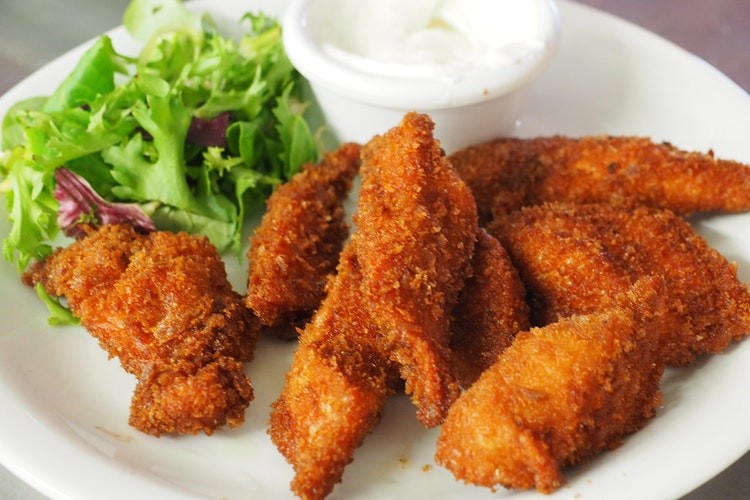
When it comes to setting up a chicken restaurant franchise, creating a detailed business plan is a crucial part of the process. Planning and organisation are often the keys to success, and if you’re interested in running your own chicken business successfully, this article will tell you everything you need to know about building a viable business plan.
Investing in a chicken restaurant franchise makes financial sense. The chicken industry is thriving and lucrative, with 60% of people recognising KFC as one of the most popular dining brands in the UK [Statista]. If you’re interested in franchising in this area and riding the chicken wave to profit, a sound business plan will help you on your way.
One of the most important activities you can do for your business to ensure you reap financial success is to plan. Planning gives your company a clear direction when mapping out your goals. You plan on the direction you would like the business to go, and the plan maps out how you will achieve those goals. – Melissa Houston, Forbes
Building a business plan for a chicken restaurant
1. tailor your chicken restaurant business plan to your intended audience .
When you’re figuring out how to build a business plan, it’s important to bear in mind who will be reading it. Is this plan intended for the bank, and meant to help you secure funding? Is it for a franchisor, during the recruitment process? Or is it primarily for your eyes?
Consider making adjustments based on the audience that you’re trying to appeal to, though key facts will stay the same. For instance, you could demonstrate proof of affordability for the bank, or explain why a planned cost/investment would generate a return for your franchisor.
Business plans are a very important part of setting up your franchise , even if the intended audience is simply yourself, as they help you to set out your priorities, make managing change more straightforward, and keep you accountable to your own plans, goals and vision. The key elements of any successful business plan, which will need to be included in yours regardless of audience, are:
- An executive summary
- A company description
- Descriptions of products and/or services
- Market analysis
- Marketing and sales plans
- Financial projections
>> Read more:
- 4 Reasons Why You Should Take the Time to Create a Business Plan For Your Franchise
2. Research the market, research your competitors, research location – just research as much as you can!
As stated, when you’re researching prior to creating your business plan, you’ll need to focus on three key areas – the market, your competitors, and the location that you’re intending to start your franchise in. Market knowledge is especially crucial, and knowing your sector well will increase your chances of success.
In the same vein, understanding your competitors is an advantage because once you know what they’re doing, you also know what they’re not doing, and you can position your franchise to fill those market gaps. You can also learn from what works for them and what doesn’t, from operational structure to marketing campaigns.
Location is an important consideration, as you’ll likely want your chicken restaurant to meet certain needs. You might also be looking for a certain amount of square footage, as per your franchisor’s guidance.
Find an opportunity, research what location would best suit that style of franchise, and then create a list of criteria that any location would need to meet in order to be suitable. Does it need parking? Should it be on a high street? These are the kinds of questions you need to know the answers to.
3. Pay attention to the finer details
Obviously, some of the information in your business plan will need to be fairly general, but wherever you can, go into the finer details and allow your audience – whether that’s a bank, your franchisor, or you in two years’ time – to fully understand your meaning and intention. Your business plan should allow any reader to:
- Understand your intentions
- Believe in your ability
- Believe in your professionalism
- Understand your experience
Common mistakes to avoid making within your business plan, avoided by paying close attention to the task at hand, include:
- Unrealistic financial projections
- Failure to define a target audience for your products/services
- Poor quality of research, or an evident lack of it
- Failure to understand your competitors
- Failure to acknowledge weaknesses and areas for improvement
- Inconsistency – in plans, in tone, in ethos etc
- Overloading the plan with unnecessary, long-winded information
4. Stand out in a saturated market by putting time and effort into advertising and marketing strategies
There are only three postcode districts in the UK (including remote Scottish islands) that don’t have a fast food restaurant [Financial Times], so it’s clear to see that there’s heavy competition in the quick service sector. To outperform others and thrive in a saturated marketplace, you’ll definitely need to consider marketing and advertising in your chicken restaurant business plan.
Look into social media marketing (SMM) in particular, as this is something many franchisees have responsibility for in their roles. Around 3.96 billion people are on social media sites across the globe [Backlinko], and SMM will play a key role in the creation of a franchise business that enjoys a regular, steady flow of loyal customers. Other benefits are that it:
- Provides you with an opportunity to tell your franchise’s story to a wider audience
- Gives you the chance to promote new products
- Is an effective, low-cost marketing option
- Connects you directly with customers
- Helps you learn about your customers and their buying patterns
- Gives valuable information about your competitors
- Increases brand awareness
- Can be a useful recruitment tool
5. Seek additional professional opinions on your business plan and respond to suggestions
Make sure you seek opinions from trusted professionals on your business plan, particularly if you’re intending to take it to a bank. Gather independent, constructive feedback and discover whether or not you’re addressed everything you needed to address and covered everything you needed to cover.
The right outside specialist can give you an unbiased view of your business, identify problem areas and recommend strategies to keep your business on track. You can hire a consultant for almost any business need, from accounting management and marketing to better business writing and phone etiquette. – Carla Goodman, Entrepreneur
- These 5 Top Chicken Franchises in the UK Are Finger-Lickin’ Good
- Q&A: Does Popeyes Chicken Franchise in the UK?
- Meet Tony Lowings, KFC CEO
- Chicken & Waffles- Why Not Create Your Own Restaurant?
Why not start a franchise in the food service industry?
Hopefully, the path to building your chicken restaurant business plan is now clear. Choose a chicken franchise that’s right for you, put in the hard work, plan ahead, and you’ll soon find success as a franchisee. If you don’t have the budget to invest with a fast food giant like KFC, be sure to consider looking into smaller franchising opportunities within the chicken sub-sector, like Rooster Shack .
Lily Sweeney , Point Franchise ©
>> Read more articles on the Chicken sector
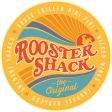
How to build a business plan for a restaurant franchise
There are certain key elements that should be included in every [...]
5 Tips for Building a Business Plan for a Successful Property Management Franchise
If you dream of running your own business and have a huge love of all [...]
4 Tips for Building a Business Plan for a Successful Burger Franchise
If you’re a burger lover who dreams of running a restaurant, you [...]
What awaits you at Franchise Expo Paris 2024
Decades of Evolution: Franchise Expo Paris Reflecting Market [...]
Celebrating the best of the best in British franchising
The Elite Franchise Top 100 (EF100) is thrilled to announce the latest [...]
The Future is Halal: Emerging Franchise Opportunities in the UK Halal Market
Embracing a Growing Market In a world that’s becoming [...]
Did you enjoy this article? Subscribe to our newsletter!
Receive up-to-date industry news, in-depth articles and the newest franchise opportunities directly to your inbox.
Post a comment
Characters remaining: 250
Keep up to date with the franchise industry
How to create a financial forecast for a fried chicken shop?

Developing and maintaining an up-to-date financial forecast for your fried chicken shop is key in order to maintain visibility on your business’s future cash flows.
If you feel overwhelmed at the thought of putting together a fried chicken shop financial forecast then don’t worry as this guide is here to help you.
We'll cover everything from: the main objectives of a financial forecast, the data you need to gather before starting, to the tables that compose it, and the tools that will help you create and maintain your forecast efficiently.
Let's get started!
In this guide:
Why create and maintain a financial forecast for a fried chicken shop?
What information is used as input to build a fried chicken shop financial forecast, the sales forecast for a fried chicken shop, the operating expenses for a fried chicken shop.
- What investments are needed for a fried chicken shop?
The financing plan of your fried chicken shop
What tables compose the financial plan for a fried chicken shop.
- Which tool should you use to create and maintain your fried chicken shop's financial forecast?
- Financial projections template for a fried chicken shop
In order to prosper, your business needs to have visibility on what lies ahead and the right financial resources to grow. This is where having a financial forecast for your fried chicken shop becomes handy.
Creating a fried chicken shop financial forecast forces you to take stock of where your business stands and where you want it to go.
Once you have clarity on the destination, you will need to draw up a plan to get there and assess what it means in terms of future profitability and cash flows for your fried chicken shop.
Having this clear plan in place will give you the confidence needed to move forward with your business’s development.
Having an up-to-date financial forecast for a fried chicken shop is also useful if your trading environment worsens, as the forecast enables you to adjust to your new market conditions and anticipate any potential cash shortfall.
Finally, your fried chicken shop's financial projections will also help you secure financing, as banks and investors alike will want to see accurate projections before agreeing to finance your business.
Need a solid financial forecast?
The Business Plan Shop does the maths for you. Simply enter your revenues, costs and investments. Click save and our online tool builds a three-way forecast for you instantly.

A fried chicken shop's financial forecast is only as good as the inputs used to build it.
If you are creating (or updating) the forecast of an existing fried chicken shop, then you mostly need your accounting information, key historical operating non-financial data, and your team’s input on what to expect for the coming years.
If you are building financial projections for a fried chicken shop startup, you will need to have done your research and have a clear picture of your competitive environment and go-to-market strategy so that you can forecast sales accurately.
For a new venture, you will also need a precise list of the resources needed to keep the fried chicken shop running on a day-to-day basis and a list of the equipment and expenditures required to start the business (more on that later).
Let's now take a closer look at the elements that make up your fried chicken shop's financial forecast.
From experience, it is usually best to start creating your fried chicken shop financial forecast by your sales forecast.
To create an accurate sales forecast for your fried chicken shop, you will have to rely on the data collected in your market research, or if you're running an existing fried chicken shop, the historical data of the business, to estimate two key variables:
- The average price
- The number of monthly transactions
To get there, you will need to consider the following factors:
- Location: The location of your fried chicken shop can greatly impact the average price and number of monthly transactions. For example, if your shop is located in a busy city center, you may be able to charge higher prices and attract more customers. On the other hand, if your shop is located in a less populated area, you may need to adjust your prices and expect lower transaction numbers.
- Seasonal Demand: The time of year can also affect your sales forecast. For instance, during the summer months, customers may be more inclined to purchase fried chicken as it is a popular food for picnics and outdoor activities. This could result in higher transaction numbers and potentially higher prices. However, during the winter months, demand may decrease, and you may need to adjust your prices accordingly.
- Competition: The presence of other fried chicken shops in your area can impact your average price and number of monthly transactions. If there are many competitors, you may need to lower your prices to remain competitive and attract customers. On the other hand, if you are the only fried chicken shop in the area, you may be able to charge higher prices and expect more transactions.
- Quality of Ingredients: The quality of your ingredients can also affect your sales forecast. If you use high-quality, fresh ingredients, you may be able to charge higher prices and attract more customers. However, if you use lower quality ingredients, you may need to adjust your prices and expect lower transaction numbers.
- Customer Reviews: Positive or negative customer reviews can have a significant impact on your business's average price and number of monthly transactions. If you have consistently positive reviews, you may be able to charge higher prices and expect more transactions. However, if you have negative reviews, you may need to adjust your prices and expect lower transaction numbers until the issue is resolved.
Once you have an idea of what your future sales will look like, it will be time to work on your overhead budget. Let’s see what this entails.
Need inspiration for your business plan?
The Business Plan Shop has dozens of business plan templates that you can use to get a clear idea of what a complete business plan looks like.

Once you know what level of sales you can expect, you can start budgeting the expenses required to operate your fried chicken shop on a daily basis.
Expenses normally vary based on how much revenue you anticipate (which is why, from experience, it is always better to start your forecast with the topline projection), and where your business is based.
Operating expenses for a fried chicken shop will include some of the following items:
- Staff Costs: This includes salaries, wages, and benefits for your employees, such as cooks, cashiers, and servers.
- Ingredients: This covers the cost of purchasing chicken, flour, spices, and other necessary ingredients for your menu items.
- Rent: This is the monthly cost of renting your fried chicken shop's physical location.
- Utilities: This includes electricity, gas, and water bills for your shop.
- Equipment Maintenance: This covers the cost of maintaining and repairing kitchen equipment, such as fryers and grills.
- Marketing and Advertising: This includes the cost of promoting your fried chicken shop through social media, flyers, and other marketing channels.
- Insurance: This covers any insurance policies needed for your shop, such as liability insurance.
- Accountancy Fees: This covers the cost of hiring an accountant to manage your shop's financial records and taxes.
- Software Licences: This includes the cost of any software needed to manage your shop, such as a point of sale system or inventory management software.
- Packaging Materials: This covers the cost of purchasing containers, bags, and other packaging materials for your food items.
- Cleaning Supplies: This includes the cost of purchasing cleaning supplies for your shop, such as detergents, sponges, and mops.
- Uniforms: This covers the cost of purchasing uniforms for your employees.
- Banking Fees: This includes the cost of transaction fees for processing credit and debit card payments.
- License and Permits: This covers the cost of obtaining necessary licenses and permits to operate your fried chicken shop.
- Training and Development: This includes the cost of training your employees and developing new recipes and menu items.
This list will need to be tailored to the specificities of your fried chicken shop, but should offer a good starting point for your budget.
What investments are needed to start or grow a fried chicken shop?
Creating and expanding a fried chicken shop also requires investments which you need to factor into your financial forecast.
Capital expenditures and initial working capital items for a fried chicken shop could include elements such as:
- Kitchen Equipment: This includes items such as fryers, grills, ovens, and refrigeration units. These are essential for cooking and storing food in a fried chicken shop and can be a significant investment.
- Furniture and Fixtures: This category includes tables, chairs, booths, and other furnishings for the dining area. These items not only provide a comfortable dining experience for your customers but also contribute to the overall atmosphere and ambiance of your shop.
- Point of Sale (POS) System: A POS system is essential for tracking sales, inventory, and managing transactions in a fried chicken shop. This system can also include features such as employee scheduling and customer loyalty programs.
- Renovations and Improvements: If you are starting a fried chicken shop in a new location, you may need to make renovations or improvements to the space to make it suitable for your business. This could include things like installing a kitchen, adding a drive-thru, or updating the exterior of the building.
- Delivery Vehicles: If you plan on offering delivery services, you may need to purchase vehicles to transport food to your customers. This can be a significant expense but can also increase your reach and customer base.
Again, this list is not exhaustive and will need to be adjusted according to the circumstances of your fried chicken shop.
Need a convincing business plan?
The Business Plan Shop makes it easy to create a financial forecast to assess the potential profitability of your projects, and write a business plan that’ll wow investors.

The next step in the creation of your financial forecast for your fried chicken shop is to think about how you might finance your business.
You will have to assess how much capital will come from shareholders (equity) and how much can be secured through banks.
Bank loans will have to be modelled so that you can separate the interest expenses from the repayments of principal, and include all this data in your forecast.
Issuing share capital and obtaining a bank loan are two of the most common ways that entrepreneurs finance their businesses.
Now let's have a look at the main output tables of your fried chicken shop's financial forecast.
The projected profit & loss statement
The projected profit & loss shows how profitable your fried chicken shop is likely to be in the years to come.
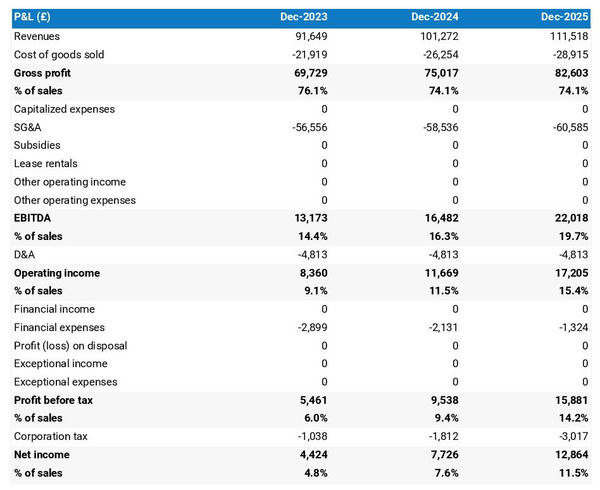
For your fried chicken shop to be financially viable, your projected P&L should ideally show:
- Sales growing above inflation (the higher the better)
- Profit margins which are stable or expanding (the higher the better)
- A net profit at the end of each financial year (the higher the better)
This is for established fried chicken shops, there is some leniency for startups which will have numbers that will look a bit different than existing businesses.
The projected balance sheet
Your fried chicken shop's forecasted balance sheet enables you to assess your financial structure and working capital requirements.
It is composed of three types of elements: assets, liabilities and equity:
- Assets: represent what the business owns and uses to produce cash flows. It includes resources such as cash, equipment, and accounts receivable (money owed by clients).
- Liabilities: represent funds advanced to the business by lenders and other creditors. It includes items such as accounts payable (money owed to suppliers), taxes due and loans.
- Equity: is the combination of what has been invested by the business owners and the cumulative profits and losses generated by the business to date (which are called retained earnings). Equity is a proxy for the value of the owner's stake in the business.

The cash flow forecast
Your fried chicken shop's cash flow forecast shows how much cash your business is expected to consume or generate in the years to come.
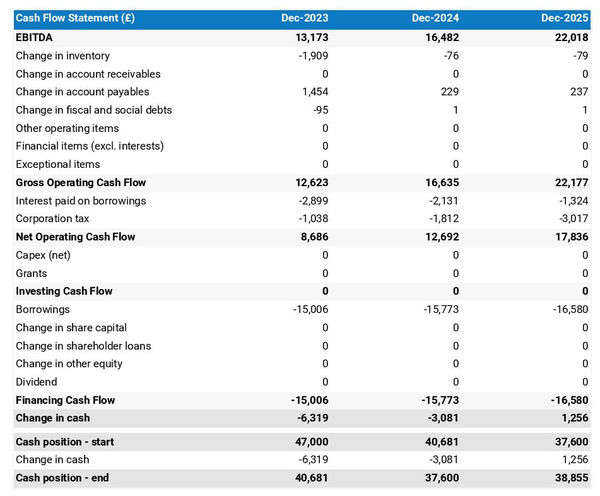
It is best practice to organise the cash flow forecast by nature to better explain where cash is used or generated by the fried chicken shop:
- Operating cash flow: shows how much cash is generated by the operating activities
- Investing cash flow: shows how much will be invested in capital expenditure to maintain or expand the business
- Financing cash flow: shows if the business is raising new capital or repaying financiers (debt repayment, dividends)
Keeping an eye on (and regularly updating) your fried chicken shop's cash flow forecast is key to ensuring that your business has sufficient liquidity to operate normally and to detect financing requirements as early as possible.
If you are trying to raise capital, you will normally be asked to provide a monthly cash flow forecast in your fried chicken shop's financial plan - so that banks or investors can assess seasonal variation and ensure your business is appropriately capitalised.
Which tool should you use to create your fried chicken shop's financial forecast?
Creating your fried chicken shop's financial forecast may sound fairly daunting, but the good news is that there are several ways to go about it.
Using online financial forecasting software to build your fried chicken shop's projections
The modern and easiest way is to use an online financial forecasting tool such as the one we offer at The Business Plan Shop.
There are several advantages to using specialised software:
- You can easily create your financial forecast by letting the software take care of the financial calculations for you without errors
- You have access to complete financial forecast templates
- You get a complete financial forecast ready to be sent to your bank or investors
- You can easily track your actual financial performance against your financial forecast, and recalibrate your forecast as the year goes by
- You can create scenarios to stress test your forecast's main assumptions
- You can easily update your forecast as time goes by to maintain visibility on future cash flows
- You have a friendly support team on standby to assist you when you are stuck
- It’s cost-efficient and much cheaper than using an accountant or consultant (see below)
If you are interested in this type of solution, you can try our projection software for free by signing up here .
Hiring a financial consultant or chartered accountant
Hiring a consultant or chartered accountant is also an efficient way to get a professional fried chicken shop financial projection.
As you can imagine, this solution is much more expensive than using software. From experience, the creation of a simple financial forecast over three years (including a balance sheet, income statement, and cash flow statement) is likely to start around £700 or $1,000 excluding taxes.
The indicative estimate above, is for a small business, and a forecast done as a one-off. Using a financial consultant or accountant to track your actuals vs. forecast and to keep your financial forecast up to date on a monthly or quarterly basis will naturally cost a lot more.
If you choose this solution, make sure your service provider has first-hand experience in your industry, so that they may challenge your assumptions and offer insights (as opposed to just taking your figures at face value to create the forecast’s financial statements).
Why not use a spreadsheet such as Excel or Google Sheets to build your fried chicken shop's financial forecast?
Creating an accurate and error-free fried chicken shop financial forecast with a spreadsheet is very technical and requires a deep knowledge of accounting and an understanding of financial modelling.
Very few business owners are financially savvy enough to be able to build a forecast themselves on Excel without making mistakes.
Lenders and investors know this, which is why forecasts created on Excel by the business owner are often frowned upon.
Having numbers one can trust is key when it comes to financial forecasting and to that end using software is much safer.
Using financial forecasting software is also faster than using a spreadsheet, and, with the rise of artificial intelligence, software is also becoming smarter at helping us analyse the numbers to make smarter decisions.
Finally, like everything with spreadsheets, tracking actuals vs. forecasts and keeping your projections up to date as the year progresses is manual, tedious, and error-prone. Whereas financial projection software like The Business Plan Shop is built for this.
Use our financial projection templates for inspiration
The Business Plan Shop has dozens of financial forecast templates available.
Our examples contain a complete business plan with a financial forecast and a written presentation of the company, the team, the strategy, and the medium-term objectives.
Whether you are just starting out or already have your own fried chicken shop, looking at our financial forecast template is a good way to:
- Understand what a complete business plan should look like
- Understand how you should model financial items for your fried chicken shop

- A financial forecast shows expected growth, profitability, and cash generation metrics for your fried chicken shop.
- Tracking actuals vs. forecast and having an up-to-date financial forecast is key to maintaining visibility on your future cash flows.
- Using financial forecasting software is the modern way of creating and maintaining financial projections.
We hope that this guide helped you gain a clearer perspective on the steps needed to create the financial forecast for a fried chicken shop. Don't hesitate to contact us if you have any questions!
Also on The Business Plan Shop
- Financial forecast example
Know someone who runs a fried chicken shop? Share our business guide with them!

Founder & CEO at The Business Plan Shop Ltd
Guillaume Le Brouster is a seasoned entrepreneur and financier.
Guillaume has been an entrepreneur for more than a decade and has first-hand experience of starting, running, and growing a successful business.
Prior to being a business owner, Guillaume worked in investment banking and private equity, where he spent most of his time creating complex financial forecasts, writing business plans, and analysing financial statements to make financing and investment decisions.
Guillaume holds a Master's Degree in Finance from ESCP Business School and a Bachelor of Science in Business & Management from Paris Dauphine University.
Create a convincing business plan
Assess the profitability of your business idea and create a persuasive business plan to pitch to investors

500,000+ entrepreneurs have already tried our solution - why not join them?
Not ready to try our on-line tool ? Learn more about our solution here
Need some inspiration for your business plan?
Subscribe to The Business Plan Shop and gain access to our business plan template library.

Need a professional business plan? Discover our solution
Write your business plan with ease!

It's easy to create a professional business plan with The Business Plan Shop
Want to find out more before you try? Learn more about our solution here
SaharaMagnate
1 on 1 business Coaching Blog in USA
How To Start A Fried Chicken Business [2023] Shop Idea
Fried chicken is one of the world’s favorite meals, and it’s no surprise why. It’s a delicious, affordable dish that everyone can enjoy.
And starting a fried chicken business could be a great way to capitalize on its popularity. But how do you get started? What should you consider when setting up your business?
This article will cover everything you need to know about starting a successful fried chicken shop in 2023 and beyond.
Read Also : How To Start A Drone Spraying Business
Also, what to consider before setting up a shop, the equipment and ingredients you’ll need, regulations and marketing tips, plus key insights from an experienced entrepreneur.
Whether you’re just starting or looking for ways to expand your existing business, this guide will help you get your chicken frying.
How To Start A Fried Chicken Business
Starting a fried chicken business is a great way to make delicious food and turn a profit in the process. It’s an exciting challenge that requires several essential steps to get you up and running.
Step 1: Assess the Local Market: What Is the Demand?
Before you jump in and start a fried chicken business, it’s vital to assess the local market to see if there is a viable demand for your product.
The best way to do this is to look at the current trends in fried chicken businesses and the competition in your area.
To start, research current fried chicken businesses and get an idea of these establishments’ size, prices, and customer base.
This will give you an idea of what kind of market exists in your area. Next, take a closer look at your potential customers.
Are there any nearby schools or businesses that might create a demand for your product? How many companies are already offering fried chicken nearby?
These questions help you determine if there is enough demand in the market for you to open a successful fried chicken shop.
By taking the time to assess your local market, you’ll be more confident that starting a fried chicken business is the right decision for you and will give you better insight into how to make it successful.
Step 2: Develop a Comprehensive Business Plan
Before you get into the nitty-gritty of starting a fried chicken business, you need to create a comprehensive business plan.
Think of it as the roadmap to get you on the right path. Your business plan should include the following:
Product Offering
Consider what type of fried chicken you’ll be serving and any additional products (such as sides and desserts) you may offer. Having an in-depth understanding of your product offering is essential for success.
Profit & Loss Statement
This document shows how much money your business brings in and how much it spends. It includes income from sales, rent, utilities, payroll, and other necessary costs for running your business. The goal is to ensure your business makes more money than it spends!
Marketing Strategy
A detailed marketing strategy will help you reach potential customers and drive sales. This will include the following;
- Deciding on marketing channels (social media, email marketing, etc.),
- Budgeting for promotions and advertising,
- Setting up customer relationship management systems,
- Optimizing search engine rankings and more.
You’ll also want to create a logo and brand identity that conveys your message clearly and appeals to customers.
It’s essential to take the time now to think through all these details to have a comprehensive foundation for your fried chicken business when it opens its doors!
Step 3: Understand the Regulations, Licenses, and Insurance Requirements
If you’re planning to open a fried chicken business, it’s essential to understand all the regulations and licenses required. Don’t forget about insurance, too—it’s essential for any business.
- Research local regulations & licensing
To successfully open a fried chicken shop, you must research local regulations and licensing requirements in your area.
You may need a permit or license depending on what type of food you plan to serve, how many people you plan to seat in your shop, etc.
- Acquire insurance
Insurance is an integral part of any business, especially regarding food services. You’ll need liability insurance, such as general liability and malpractice/professional insurance, as well as employee-related insurance, such as workers’ compensation and disability insurance.
Be sure to get the right type of insurance for your type of restaurant, and make sure the policy fits within your budget.
Check with local health inspectors for additional requirements that may apply — they may vary from state to state or city to city!
Researching regulations and acquiring the necessary licenses and insurance can be time-consuming, but it’s necessary for maintaining your fried chicken shop in good standing with authorities.
Ensure you understand all these requirements before opening your restaurant—it could save you time, money, hassles, and headaches in the long run!
Read Also : How To Start A Pallet Flipping Business
Step 4: Find the Right Location for Your Shop
Finding the right location is crucial to starting a fried chicken business. After all, it will be where customers come to enjoy your tasty fried chicken meals.
Accessible, Visible Location
When selecting a location for your fried chicken shop, ensure it’s accessible and visible to your target customer base.
It’s crucial that the location is accessible for customers to get to and is visible from prominent streets and highways in the area. That way, people will be more likely to find your shop without much hassle.
Look At Other Factors
Also, consider other factors when selecting a location for your business. For example, see how much foot traffic there is in the area and how close it is to areas your target market frequents.
Also, check out how much rent or mortgage costs would be in the area and if any tax incentives are available.
When choosing a location for your fried chicken shop, consider all of these factors to find an optimal nearby spot that suits your needs. That way, you’ll have a great place to serve delicious dishes for hungry customers.
Step 5: Source Quality Ingredients for Your Fried Chicken Recipes
So you’re ready to take on the fried chicken world, but how do you ensure your fried chicken recipes are up to scratch?
An essential ingredient to quality is natural good-quality ingredients. This means buying fresh chicken and never compromising on the quality of what you put in your recipes. You want to opt for organic, free-range, or even pasture-raised chickens that are high in flavor so your customers keep returning for more.
Aside from the main ingredient—chicken—you’ll also need flavorings. This includes everything from spices, herbs, and seasonings to marinades and oils.
Try different combinations of flavors to find out which ones work best for your fried chicken recipes. Stick with a simple combination of flavors if you’re starting.
- Dry vs. Wet Rubs
One way to give your fried chicken dishes more flavor is with a dry or wet rub, a mixture of spices used as a marinade on the chicken before frying it.
Dry rubs tend to contain only spices, while wet rubs usually have liquids like oil and vinegar as part of the mix.
Your type will depend on how much time you have to prepare your dish and how bold a flavor you want it to have.
It’s also worth considering pre-mixed spice blends instead of making all the individual ingredients yourself—it saves time and effort. It gives you plenty of options when experimenting with flavor combinations!
With some practice and creativity, sourcing quality ingredients can help make your fried chicken business stand out in 2023.
Step 6: Set Up Your Kitchen and Create an Environment That Promotes Sanitation and Food Safety
A fried chicken business is only complete with a well-stocked kitchen. It’s essential to create an environment that prioritizes food safety and sanitation. To do this, you’ll need to invest in equipment and materials that meet industry standards for safety and sanitation.
Here are a few things you’ll want to include in your kitchen setup:
Commercial fryer
A commercial-grade fryer will make sure your chicken is fried to perfection every time, without the risk of over or undercooking it.
This is also important for food safety, as a fryer helps maintain consistent temperatures and prevents potential bacteria from growing on the chicken.
Refrigeration unit
Having adequate refrigeration is essential for preserving all the ingredients that go into making delicious fried chicken.
Having separate compartments with different temperatures will help ensure food quality and safety standards are always maintained.
Storage containers
You’ll need plenty of storage containers to organize all the ingredients and condiments you’ll be using, so make sure you have enough containers of various sizes to store everything properly.
By investing in the right equipment and materials, you can set up an efficient kitchen focusing on food safety and sanitation—all while serving some delicious fried chicken!
Starting a fried chicken business in 2023 is no easy feat, but with the proper preparation, marketing strategy, and customer service, you can be well on your way to success.
The keys are to have a strong concept that resonates with your local market, research your competition, keep track of your expenses and profits, and find a reliable and high-quality supplier.
You should also consider investing in digital marketing , such as social media and email marketing, to spread the word about your business.
By taking the time and effort to do your due diligence and having a unique approach to your fried chicken business, you can ensure that your shop will stand out from the competition.
With hard work and dedication, 2023 could be the year your fried chicken shop dreams become a reality.
Leave a Reply Cancel reply
Your email address will not be published. Required fields are marked *
Save my name, email, and website in this browser for the next time I comment.

Fast Food Business Plan Template
Over the past 20+ years, we have helped over 7,000 entrepreneurs and business owners create business plans to start and grow their fast foods.
Below are links to each section of your fast food business plan template:
Next Section: Executive Summary >
Fast Food Business Plan FAQs
What is the easiest way to complete my fast food business plan.
Growthink's Ultimate Fast Food Business Plan Template allows you to quickly and easily complete your Fast Food Restaurant Business Plan.
Where Can I Download a Fast Food Business Plan PDF?
You can download our fast food restaurant business plan pdf here. This is a business plan template you can use in PDF format.
What Is a Fast Food Business Plan?
A business plan provides a snapshot of your fast food restaurant as it stands today, and lays out your growth plan for the next five years. It explains your business goals and your strategy for reaching them. It also includes market research to support your plans.
Why Do You Need a Business Plan?
If you’re looking to start a fast food restaurant or grow your existing one you need a business plan. A business plan will help you raise funding, if needed, and plan out the growth of your fast food restaurant in order to improve your chances of success. Your fast food business plan is a living document that should be updated annually as your business grows and changes.
What Are the Sources of Funding for a Fast Food Restaurant Business Plan?
Fast Food restaurants are usually funded through small business loans, personal savings, credit card financing and/or angel investors.
This is true for a traditional fast food restaurant, a quick service restaurant and a takeout restaurant business plan.
FAST FOOD BUSINESS PLAN OUTLINE
- Fast Food Business Plan Home
- 1. Executive Summary
- 2. Company Overview
- 3. Industry Analysis
- 4. Customer Analysis
- 5. Competitive Analysis
- 6. Marketing Plan
- 7. Operations Plan
- 8. Management Team
- 9. Financial Plan
- 10. Appendix
- Fast Food Business Plan Summary
Start Your Fast Food Plan Here
Other Helpful Business Plan Articles & Templates

Got any suggestions?
We want to hear from you! Send us a message and help improve Slidesgo
Top searches
Trending searches

infertility
30 templates

16 templates

49 templates

27 templates

frida kahlo
56 templates

el salvador
32 templates
Fried Chicken Restaurant Business Plan
Fried chicken restaurant business plan presentation, free google slides theme and powerpoint template.
Everyone loves fried chicken! It’s not only a food, but a culture: getting all together, sharing a fun evening, maybe watching a game… if you want to open a business that offers all this, this business plan is the perfect ally for your team. Dip into these slides and share your projects in a cool, creative way, the spice of this presentation is: lots of editable resources and decorations!
Features of this template
- 100% editable and easy to modify
- 73 different slides to impress your audience
- Contains easy-to-edit graphics such as graphs, maps, tables, timelines and mockups
- Includes 500+ icons and Flaticon’s extension for customizing your slides
- Designed to be used in Google Slides and Microsoft PowerPoint
- 16:9 widescreen format suitable for all types of screens
- Includes information about fonts, colors, and credits of the resources used
How can I use the template?
Am I free to use the templates?
How to attribute?
Attribution required If you are a free user, you must attribute Slidesgo by keeping the slide where the credits appear. How to attribute?
Related posts on our blog.

How to Add, Duplicate, Move, Delete or Hide Slides in Google Slides

How to Change Layouts in PowerPoint

How to Change the Slide Size in Google Slides
Related presentations.

Premium template
Unlock this template and gain unlimited access

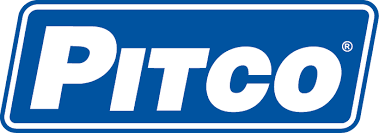
- Solstice Supreme
- Flat Bottom Fryer
- Megafry Fryers
- Countertop Fryer
- HOLDING & MERCHANDISING
- Built-In Filtration
- Portable Filtration
- Oil Reclamation
- Pasta Cookers
- Rethermalizers
- Filter Paper
- Tank Racks & Screens
- Fryer Cleaning Accessories
- Tank Covers
- Splash Guards
- SGBNB Dump Station
- Technologies
- Grocery and Retail
- Fried Chicken
- Electric Equipment
- Chicken Wings
- Training Guides
- Product Documents
- Energy Star
- Repair Or Replace?
- Fryer Product Selector
- ORDER LOOKUP
What You Need for Profitable Fried Chicken

Fried chicken is one of the most popular — and profitable — endeavors in foodservice. Over the last several years, it’s been at the top of several trends lists as a way to help operators improve their bottom lines, but a successful fried chicken program doesn’t exist in a vacuum. It starts with an idea and ends in the fryer.
A Winning Fried Chicken Recipe
As a southern fried chicken purist, maybe you decided it’s time to share your love for the homey simplicity of your buttermilk, flour-dredged specialty. On the other hand, you may have perfected an adobo-style fry – the vinegary Philippine favorite that adds a peppery kick. The sweet and sour crunchiness of a Korean fried delicacy could be where you’ve fine-tuned your taste buds. Of course, the buttermilk brine and hot cayenne flavor balanced in the Nashville hot mixture is an American crowd-pleaser that’s here to stay.
No matter what your recipe, it’s important to have your own style. Make it secret if you need to. Just remember, this is the idea that set your operation in motion.
A Fryer That Can Deliver Quality Chicken in Larger Volumes
Once the word is out, the lines are running out the door. Now more than ever it’s important to have commercial fryers that can deliver high quality in larger volumes. Adopting a process that maximizes your resources is crucial to your fried chicken business. Whether you serve a weekly three-course special that produces 30 orders, or you supply hundreds of pieces a week, chicken automation is the key to profitability.
Choose the fried chicken equipment that’s going to enhance your recipe by cooking each piece to crunchy, golden-brown perfection. A budget-stretching option is the reduced oil volume (ROV) Rack Fryer from Pitco.
ROV Rack Fryers from Pitco
The Solstice Series gas and electric fryers provide a variety of size and cabinet combinations and fuel adaptability to suit your kitchen needs. Simply put, an ROV fryer uses less oil while delivering higher volume, helping you earn more from production while saving more from oil usage at the same time. But those aren’t the only advantages.
A top-off feature maintains an ideal frying level while replacing the oxidizing oil with fresh oil through the filtering process. Oil is automatically replenished before it has a chance to oxidize and deteriorate. While an automatic filtration system provides a higher level of efficiency and safety for those who operate the fryer.
Always keep in mind a frequent oil filtration schedule enhances the quality of your product while improving profitability.
Why Should You Consider the ROV Rack Fryer?
If the popularity of your recipe has reached a need for a higher level of production and chicken automation, it may be time to consider the ROV Rack Fryer . The Pitco ROV Rack Fryer improves upon the Legacy Rack Fryer:
- Oil reduced from 100 to 73 pounds
- Throughput capacity increased from 48 to 64 pieces of chicken
How Pitco’s ROV Rack Fryer stacks up to the competition:
- Produces 320 as opposed to 196 pieces of bone-in chicken in one hour and 45 minutes
- Innovative signal IQ control – level sensor for the collection of sediment
Simply load the chicken, set the controls, and walk away. The ROV Rack Fryer takes care of frying your chicken to perfection while you tend to other aspects of your business.
A Fryer Partner Who Can Be a Knowledgeable Resource
The experts at Pitco have been improving on the frying method since the 1918 invention of the Pitco Frialator . Discovering a way to remove the sediment at the bottom of the fry pot and improve the overall quality of fried foods was only the beginning of the company’s innovative vision. Schedule a free fryer consultation with a member of the Pitco team to discuss how you can increase productivity and profitability.

- Foods & Trends (70)
- Fryers (56)
- Fried Food (35)
- Filtration (24)
- Chicken (20)
- Solstice (18)
- Safety (10)
- History (8)
- Management (8)
- Accessories (8)
- Chicken Wings (7)
- Automation (4)
- Maintenance (4)
- French Fries (4)
- SOS SmartOIL Sensor (3)
- Quality (3)
- Controls (3)
- Rack Fryer (3)
- Financing (3)
- Fresh Breaded (3)
- Infinity Touch (2)
- Installations (1)
- jalapeno popper (1)
- C-stores (1)
- Pasta Cooker (1)
- Rethermalizers (1)
- See All Topics
- Videos and Instructions
- Free photo gallery
- Recipes and training
Open Your Chicken Restaurant
- Chilli Mili Franchise
- Company History
- Order Starter Kit

ARE YOU THINKING ABOUT STARTING YOUR OWN RESTAURANT BUSINESS?
Do Kebab bistros, pizzerias and ice cream shops prosper in your town? That’s good news! Bring something new to the table. Crispy battered chicken doesn’t have strong competition on the market, and it is a dish loved by everyone! We offer you full support if you decide to open your own crispy-coated chicken restaurant.
We offer flexible business relationship, one, which allows you to take advantage of the full range of solutions we offer, or only the ones you need. We will enable you to work independently, and we provide constant support. Use our experience and knowledge. You make decisions on how your restaurant should look like, and you decide on its budget.
Find out how we can help.
NAME AND LOGO
Have you already got a name and logo for your restaurant?
The right, appetizing, easy-to-remember name for your restaurant that has the right graphic design is the correct direction in creating a recognizable brand. If you are thinking about how to name your restaurant and how to choose a logo, check our suggestions. You will find a few examples below. Every logo can be modified, so your restaurant stands out in the local market!

PREMIUM MENU & PHOTOS OF PRODUCTS
We have developed a complete restaurant menu based on battered chicken dishes. You may use all the recipes on our menu or only the ones you like. You can make your own adjustments to it as well.
We will provide you with quick recipes for all the dishes on the menu- starting with bucket of hot wings and fries, to all sorts of burgers, tortillas and chicken salads.
Every recipe lists all of the ingredients in detail, their weight, the order and method in preparation, the suggested name for the dish, the serving method for both eat in and take away, and a suggested retail price along with the production cost calculation.
All of the dishes on the menu have been photographed, and the pictures depict realistic dishes. Take a look at the entire menu list below. The high quality of the photos will let you make exclusive promotional content such as fliers, posters, banners, wall screens. The images are also ideal for marketing in the press and social media.

Example instruction

Tortilla Classic Y15
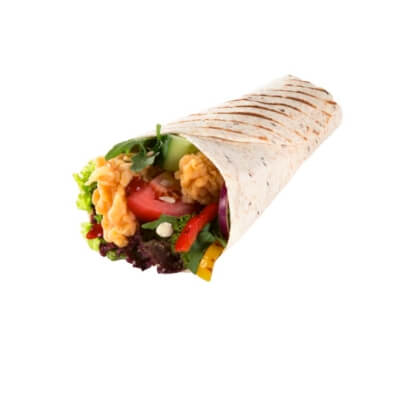
Big Monster Y6

Big Boss Y3
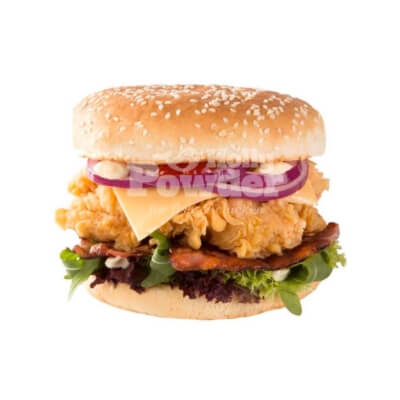
Lumberjack Y11
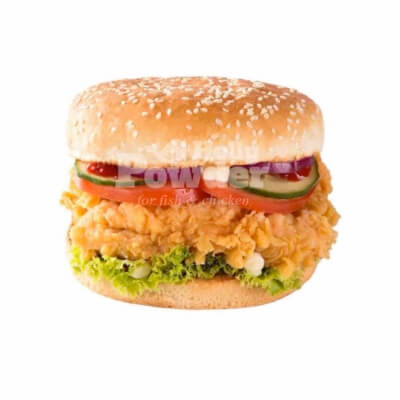
Freedom Y10

Mr. Cheese Y12

Rooster Y14

Bekon Rooster Y1
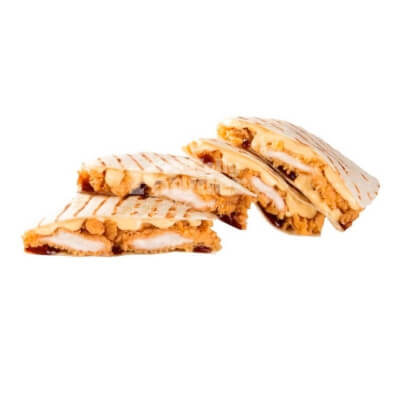
Qurrito Y13
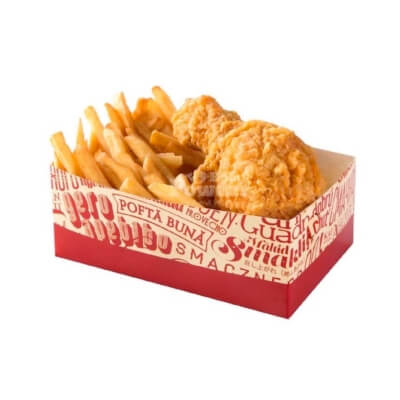
Be-Fast Drumstick C1

Be-Fast Strips C2

Be-Fast Wings C3

Box Rooster C5
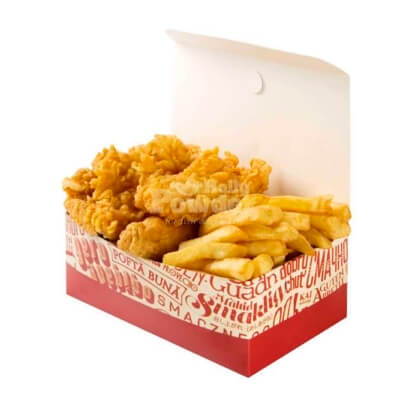
Box Strips C6

Bucket Mix&Chips D1
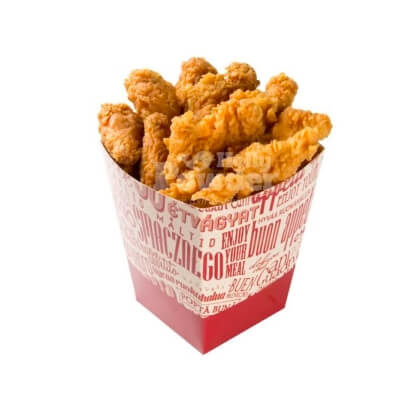
Bucket Mix D2
Price list & flyers .
The right advertisement and the proper dish promotion is essential to remember when opening a new crispy chicken restaurant.
To make the task easier, we have developed price lists, menu boards and fliers, all based on individual menu items. All crispy chicken marketing content is cohesive and complete, and it will help you work in your local market. The content can be edited, you can place your logo and prices onto it.

Menu board X1

Menu board X2

Menu board X3

Menu board X4
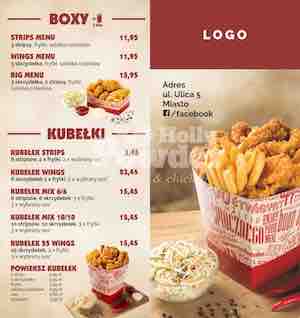
Price list X7

Price list X8
Don’t forget to advertise your dishes!
Find a visible place within your restaurant, which can be designated for an ad poster. Take advantage of the crispy chicken posters we have made available for you. All of them can be edited, and you can place your logo and prices onto them. We know that restaurant customers love holiday specials and new things, and for that reason, we have made seasonal posters.
Stay in touch with us; we are always growing our promotional content.

TRAINING IN GASTRONOMY
Do you need specialized training for your employees? Maybe you are considering a journey through the word of gastronomy and need a professional introduction?
Open your own chicken restaurant and take advantage of our training package. Our qualified chef will visit your restaurant. He will show you how to marinade and coat chicken meat in batter properly, and how to prepare every dish on the menu. He will also show you how to work in the kitchen efficiently.

TECHNOLOGY & EQUIPMENT
Did you know that many restaurant owners are already enjoying running their restaurant based on our crispy chicken? It is a sign of success for us! It also provides us with rich knowledge and experience. We know which technological solutions will work well in the kitchen and how to design the working area properly. We also work with a sanitary specialist who knows the technology and kitchen specifications based on crispy-coated chicken very well.
You will receive an operation manual from us where you will be able to find detailed shopping lists of big and small appliances necessary to run your kitchen. You will save time and money, and you can be sure you have the right tools for the job.

Pressure fryer

Food warmer showcase

operation manual 1

operation manual 2
Facebook and internet photos .
It is vital to promote your dishes well! Take advantage of our vast gastronomy picture gallery. Post them on Facebook, your website, and other social media outlets. Show your appetizing menu to your customers and make them want to come to your restaurant.
Take a look at our free picture gallery.
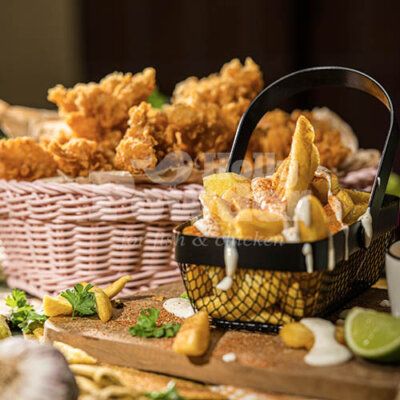
Simple photo E43
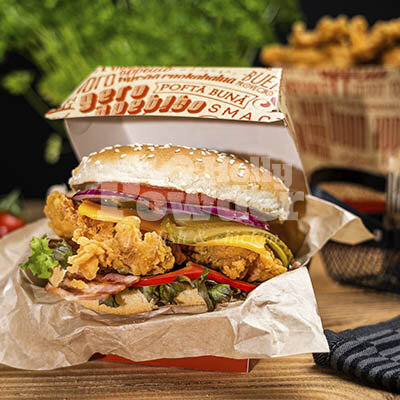
Simple photo E33

Simple photo E52
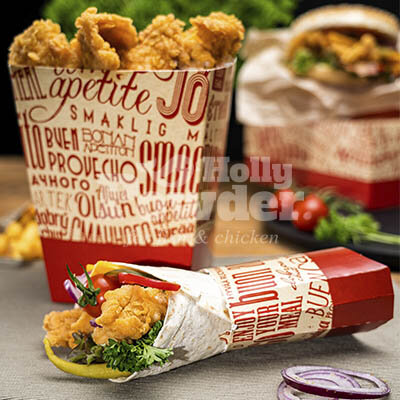
Simple photo E35
Ideas to run your own gastronomy business .
Open your own fried chicken restaurant.
If you’d like to take advantage of the great business model and tested solutions for a state-of-the-art fried chicken restaurant, check our Chilli Milli franchise opportunity .
Stay up to date with our latest news. Get advice from Cartel Foods’ catering industry and marketing experts.
Call or write us if you are interested in business cooperation.
Would you like to learn more about our company? Call or write us today!

Sales - International

Contact form - fast delivery
Learn about our brands:

- Privacy Policy and cookies
Business Plan Prepared By - French Fried Chicken
- Download HTML
- Download PDF

- World Around

- Uncategorized

- Hobbies & Interests

- Food & Drink

- Style & Fashion

- Health & Fitness

- Government & Politics

- IT & Technique

- Home & Garden

Chicken Shop Business Plan Sample PDF Example | Free Download Presented by BizMove

Watch This Video Before Starting Your Chicken Shop Business Plan PDF!
Checklist for Starting a Chicken Shop Business: Essential Ingredients for Success
If you are thinking about going into business, it is imperative that you watch this video first! it will take you by the hand and walk you through each and every phase of starting a business. It features all the essential aspects you must consider BEFORE you start a Chicken Shop business. This will allow you to predict problems before they happen and keep you from losing your shirt on dog business ideas. Ignore it at your own peril!
For more insightful videos visit our Small Business and Management Skills YouTube Chanel .
Here’s Your Free Chicken Shop Business Plan DOC
Free book for you: how to start a business from scratch (pdf).
Copy the following link to your browser and save the file to your PC:
https://www.bizmove.com/free-pdf-download/how-to-start-a-business.pdf
Multiple Unit Pricing
You can increase the size of your individual sales by offering a meaningful discount for larger purchases. A liquor store usually will offer a discount or throw in a free bottle of wine when you buy a case. The same idea applies to the "baker's dozen," a discount on a "set" of tires or selling beer and soft drinks by the pitcher. This is a good technique for building customer goodwill, but you will not see your customers as often. The trade-off, of course, is that you save time and money on containers and packaging, save time by writing up fewer sales and, perhaps, can make your delivery service more efficient by selling by the truckload. Variations are "two-fors," "six-packs," "cheaper by the carton" and "bulk price."
Suggested Retail Pricing
This is the practice of selling at prices set by your suppliers. It is convenient because many product lines are available prepackaged and prepriced. However, you lose flexibility and must live with a set percentage markup. (To combat this disadvantage, some suppliers offer "two-for-three" options using the retail price). Because suggested-retail or retail-price-maintenance plans are illegal in some states, the practice usually is a loser. Using a slightly different strategy, Panasonic published a "minimum retail" price list showing a higher "average retail"; some stores use such gimmicks as "compare at" or "nationally advertised at" to imply that the "official" price is at a certain point.
Discount Pricing
The discount store usually offers lower prices as a trade-off for spartan interiors, lack of sales help and the efficiency of central checkouts. These stores typically work on a 35 to 38 percent markup compared to 42.5 to 45 percent for a department store. Since discount stores depend on the efficiency of greater volume to cover operating costs, they must maintain, or at least promote, good prices.
Full-cost Pricing
This pricing is calculated by adding the costs of the product or service plus a flat fee or percentage as the margin of profit. During inflation, you must keep track of your costs to make sure that you are charging enough. In many business lines, owners have come to realize that when they replace their stock, the wholesale price has often risen above their retail price. If they do not raise prices rapidly enough, they are faced with diminishing inventories at a constant dollar investment or with having to invest more money to restock their shelves at the constant level.
Keystone Pricing
This refers to the practice of setting the retail price at double the cost figure, or a 100 percent markup. It is most common with jewelry items and in specialty shops, high-ticket fashion shops and department stores. Typically, the merchandise is subject to drastic clearance markdowns on items that are slow sellers or held past the season.
Price Lining
This is the technique used by most retail stores of stocking merchandise in several different price ranges. A hardware store, for example, may carry hammers in good, better, and best categories at $6.49, $12.49 and $19.98, respectively, and a professional model at $27.95. The theory is that people buy products with different uses in mind and with different expectations for quality and length of useful life. If you do not carry a range of prices, you may lose the customers who cannot find the product at the right price. Price lining simplifies buying and inventory control because you buy only for the price levels that you know your customers will accept and eliminate those goods that fall outside the levels you want to carry.
Competitive Advantage
Here is where you copy or follow the prices set by your competition. Based on your service image, you can set your prices equal to, above or below those of your competition. This strategy requires constant vigilance by reading the ads and shopping your competition. It is a more passive technique because you're always following your competitors. Chances are your more aggressive competitor can make better purchases than you. A variation of this is the we-won't-be-undersold routine, where you offer to meet or beat the prices of all your competitors.
Pre-season Pricing
Many manufacturers offer price discounts or dated billing as incentives to buy early. This is important to manufacturers because of production planning and the lead time necessary for ordering raw materials. For the retailer, the same principles apply; also, off-season specials may be a way to profit in business on a year-round basis. When you sell at a lower price to get the early sales, you may be borrowing from later full price sales. On the other hand, anyone who has tried to buy snow tires during the year's first snowstorm knows the extent of delivery problems. In this case, early sales at a lower price would have allowed the merchant to serve the customers better and to capture sales that may be lost due to limited service facilities.
Price Is No Object
This refers to certain marketing situations in which the quality of the product or service is far more important than the price. If you need a kidney transplant, for example, you are not going to shop around and haggle over price. And even if you do press the doctor, he probably will quote you a range with a $5,000 spread rather than giving a specific number. The same is often true with high ticket fashions and jewelry. Using the same psychology, expensive automobiles and boats are not sold on price. They may use a starting at or base price to get people interested, but the prices of the options are usually in very small print. The extreme of this attitude is that if you have to ask the price you probably cannot afford the item anyway.
As Soon as You have Determined what Kind of business you want to Begin and The investment requirements, you are ready to select a location. The number of competitive businesses already in the region should affect your choice of location. Some areas are overloaded with service channels or certain forms of restaurants. Check on the number of your kind of business from Census figures, the yellow pages, or by checking out the location. Factors Aside from the potential market, availability of employees And number of aggressive businesses have to be considered in choosing a location. For example, how adequate are utilities - sewer, water, power, gas? Parking facilities? Fire and fire protection? What about home and environmental things such as schools, cultural and community actions for employees? What is the average cost of the location in taxes and rents? Check on zoning regulations. Assess the business of the local business-people, the aggressiveness of civic organizations. In summary, what is the city soul? Such factors should provide you an idea into the city or city's future. Chambers of Commerce and nearby universities Normally Have made or Are knowledgeable about local polls that can provide answers to these questions and the many other questions that will occur to you. Then you have to decide in what part of town to locate. If the city is Very small and you're establishing retail or service business, there will probably be little option. Just 1 shopping place is present. Cities have outlying shopping centers along with the central shopping area, and stores spring up along principal thoroughfares and local streets. Think about the shopping center. It's different from different locations. The shopping centre construction is pre-planned as a merchandising unit. The site has been intentionally selected by a programmer. On-site parking is a common feature. Clients may drive , park and do their shopping in relative safety and speed. Some centers provide weather protection. Such amenities make the shopping centre an advantageous location. There are also some limitations you ought to know about. As a renter, You become a part of a merchant group and must pay your pro rata share of their budget. You have to keep shop hours, light your windows, and place your signals according to established rules. Many communities have restrictions on evidence along with the middle management may have additional limitations. Moreover, if you're thinking about a shopping center for your first shop you may have an additional issue. Developers and owners of shopping facilities look for successful retailers. The kind and variety of merchandise you carry helps determine the Type of purchasing area you choose. By way of example, clothing shops, jewelry stores and department stores are more likely to be successful in shopping districts. On the other hand, grocery stores, drug stores, filling stations, and bakeries usually do better on main thoroughfares and local streets beyond the shopping districts. Some sorts of stores customarily pay a very low rent per square foot, while others pay a high rent. In the"low" category are furniture, grocery and hardware stores. In the"large" are cigar, drug, women's furnishings, and department stores. There's no hard and fast rule, however it's helpful to see in which type of area a shop like yours often seems to flourish. After determining an area best suited to your type of business, Obtain as many facts as you can about it. Examine the competition. How many similar companies are located nearby? What exactly does their sales volume seem to be? If you are establishing a shop or service trade, how far is it that people come to exchange in the area? Are the visitors patterns positive? If most of your clients will be local inhabitants, research the population trends of the region. Is population increasing, stationary or decreasing? Are the folks native-born, mixed or chiefly foreign? Are fresh ethnic groups coming in? Are they mostly laborers, clerks, executives or retired persons? Are they all ages or mostly retired, middle aged, or young? Judge purchasing power by checking average house rental, average property taxes, number of telephones, number of cars and, if the amount can be obtained, per capita income. Larger shopping facilities have this sort of information available, and will make it accessible to serious prospective tenants. Zoning ordinances, parking availability, transport facilities And natural obstacles - such as bridges and hills - are all important factors in locating any kinds of company. Possible sources for this information are Chambers of Commerce, trade associations, real estate companies, local newspapers, banks, city officials, neighborhood merchants and personal observation. If the Bureau of the Census has developed census tract information for the particular region where you're interested you will find this especially helpful. A census tract is a small, permanently established, geographical place within a big city and its environs. The Census Bureau provides population and housing characteristics for each tract. This information can be valuable in measuring your marketplace or service potential. Deciding upon the actual site within an area may well be taking what you May get. Not too many buildings or plants will be appropriate and at the same time, available. If you do have a choice, make sure you weigh the chances carefully. For a production plant, think about the condition and suitability Of the construction, transportation, parking facilities, and also the type of lease. For A store or service establishment, assess on the closest competition, traffic Leak, parking amenities, road location, physical facets of the construction, Kind of lease and price, and the rate, price and quality of transportation. Also Investigate the history of the site. Find answers to these questions as: Has the Building remained vacant for any amount of time? Why? Have various types of Stores occupied it for brief periods? It may have proved unprofitable for them. Sites where many enterprises have failed ought to be avoided. Vacant buildings Don't attract traffic and are generally considered bad neighbors, therefore check on nearby unoccupied buildings.
brick-and-mortar bridal building-material bulk-sms burger bus business-broker business-coaching cabinet-making cake cake-shop campground camps-for-children candy candy-apple car-import car-painting carpet-installation cbd cell-phone-repair charter-fishing chauffeur chicken-shop childrens-party-planning childrenwear chocolate christmas-light-installation cigar-lounge cinema-hall cinematography civil-contractor clothing clothing-line cna cnc-machine coffee-van collection-agency commercial-cleaning computer-shop concrete content-writing cookie cosmetics-retailing cpr-training craft-beer crafts credit-repair crochet crystal csa-farm
Copyright © by Bizmove.com. All rights reserved.
Business Ideas
Investment Ideas
Make Money at Home
- Bitcoin and Xcoins
- Earn On Social Networking
- Freelancing
- Make a Website
- Money Making Apps
- Affiliate Marketing
- Online Surveys
- Start a Blog
- Web Hosting
Startup Ideas
- Your Passion Your Money
Make Money Online
How to Open a Chicken Shop/Center in India: Investment, Profit Margin, License, and Business Plan
Table of contents, financing your chicken shop, choose a suitable location for your chicken shop., know the laws , you will need a supplier, hire the staff , buy the tools required for your chicken shop., investment needed for your chicken shop business, start your sales, market your product, profits involved in a chicken shop business, ensure you provide excellent customer service , how to take a chicken shop franchise in india, benefits of opening a chicken shop franchise.
Cooking meat is a common practice globally, particularly on special occasions. In addition, chicken meat is a popular protein source for many people. For all of the above reasons, establishing a chicken shop business is an excellent choice for anybody looking to earn extra cash. So let’s check out how to open a chicken shop/center in India.

In the following years, meat production will account for a significant share of the food industry, implying that you’re on the right path to choosing a business to start. So naturally, the most distinguished and profitable meat-selling firm is the one that has the best reputation. However, meat businesses need more than passion; they also need fundamental knowledge and planning.
How to open a chicken shop/center in India
Finance is essential for every business to run. If you want to start a chicken shop business, you’ll need money to cover your beginning costs, your first inventory, and the purchase of necessary equipment. Before launching your business, be sure you have all the funding you need. You’ve had to pay for certain significant items when it comes to money. The bank can provide you with a loan to get your venture off the ground.
You’ll need a place to shop on the side of a market or on a busy street where customers will likely go by for a chicken shop. You can also rent this place. A great location is essential if you want people to know about your shop. Look for a spot where people go by every day on a busy roadway. If you’ve got a location that’s easy to go to on the way home from work, you’ll have an advantage over your competitors.
In case you missed it: How to Start a Chicken Pickle Business
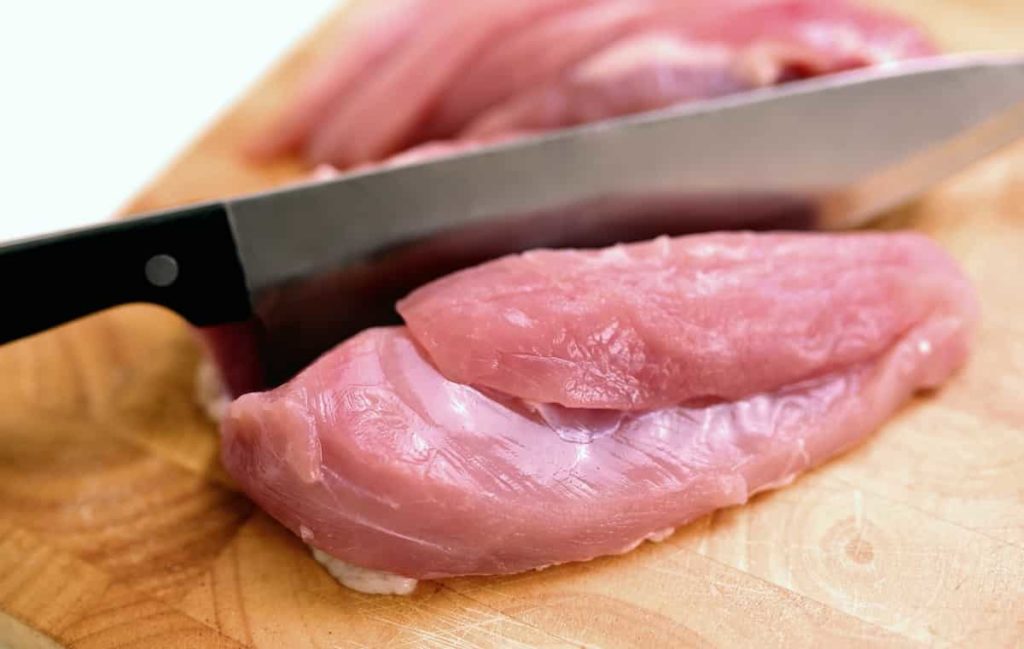
Finally, you’ll need to fill out a few paperwork forms before you can open your doors for business. Before launching a new business, you’ll need lots of new licenses and permissions, some specific to your sector, like a restaurant. Additionally, you may be required to get several assignments. These organizations may be able to provide you with some legal guidance on how to establish a chicken market business.
Maintaining good working relationships with your suppliers is necessary for operating a business. The price and availability of each provider will also influence your decision. Certain suppliers may provide complimentary supplies or machines for new companies to get you up and to run.
Your shop will function more smoothly if you have the money to recruit employees. You’ll have more time to focus on growing your chicken business if you have workers to assist you in serving consumers. Even your coworkers can help you succeed.
Butchering is a skill, and a craft needs tools, so whether or not you sell artisan meats, you still need to have the proper equipment. There are also a lot of sharp products in this chicken store company that needs to be protected. For the chicken store, you’ll need the following items: Meat slicers and grinders; scales; freezers; gloves; clothing; guards; eye protection; and other equipment. The necessities, such as trays, soap, and plastic wrap, are included.
In case you missed it: Earn Money with Country Chicken, Cost, Profit

Chicken is a common ingredient in many of today’s most popular recipes. You can create a meat market if you seek methods to generate money. If you’re searching for a company with a constant flow of consumers, opening a meat market is your best bet. Consider these handy tips if you’re thinking about opening a meat market.
Have at least Rs.1-to-2 lakh in funds set aside for investment. Store and storage are necessary to ensure that meat is appropriately preserved. To attract customers, your business should be located in a bustling market. There may be a lot of competition in the meat market, so you need to stand out. With a solid supplier and money management, you’ll be able to stay afloat for a long time.
Sales are essential for any business to grow up. Free meat and a discount are a must for getting your company off the ground. This is a way to boost your company’s profitability. Increasing revenues in your company may be achieved by negotiating with a restaurant to provide meat. Innovative thinking is required if you want to see an improvement in your profits. It’s best if you’re excited about what you’re doing. You have a better chance of success if you provide meat items and excellent customer service.
In today’s world, you can utilize the internet to your advantage in your business. Offering your services to significant poultry eggs and meat supplier is an excellent method to advertise and promote your chicken business. Using social media marketing, you can advertise and promote your chicken shop. Social media and Google Maps have revolutionized how we do things these days. You can market your chicken store on Facebook by creating a business page. In this approach, you’ll be able to draw in new consumers.
In case you missed it: Top 15 Franchise Businesses in India

Additionally, you can add your company to Google Maps as well. As a result, the customer will have a simpler time getting to your store. If you want to provide special discounts on holidays like Eid or Bakrid, you can advertise them on Facebook. With social media marketing, you can earn huge reach and higher profits. You can hire some online and offline marketing experts to assist you in promoting your chicken store. You need to pay them a proportion of their earned sales.
Advertisement is an excellent method of promoting and marketing your company. It’s a great way to get the word out about your goods. Advertising is a risk-free investment for any company. Most advertising initiatives are profitable over time. Many people prefer to acquire their fresh eggs and chicken while they are in the comfort of their own homes, so home delivery is a viable option. Your business will benefit greatly from this strategy. If presented in a visually attractive package, your product will stand out from the crowd.
In-store advertising can make good use of eye-catching packaging. On the other hand, a branded product is more accessible to spot than an unbranded one. So, make sure that your brand is prominently shown on the packaging, which will help shoppers remember your meat. A website is a low-cost method that can reach many people in terms of marketing. An advanced advertising effort is under place.
Profit margin is enormous when you cultivate your chicken, with approximately 50% profit margin in a chicken business. You might expect a profit margin of around 35% in a chicken shop if you purchase and sell chicken. In reality, if you consider the following facts before opening the chicken store, you will be able to boost your profits and succeed in your business.
In case you missed it: How to Start Meat Export Business in India
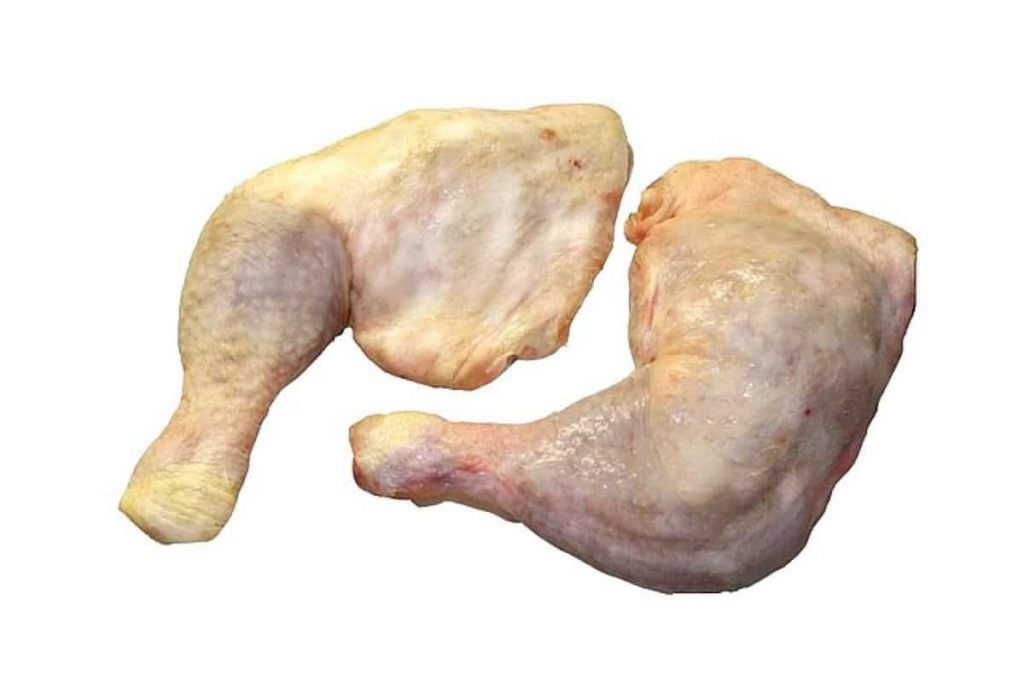
Customers have the power to widen your sales. As a result, excellent customer service can lead to increased sales. Correct any errors you’ve made before dealing with consumers. When interacting with them, avoid using any unpleasant language. Please make sure you get back to them right away, as well. Please call to the bottom of their issues as soon as possible. Your chicken shop can profit from using these marketing tactics. It doesn’t matter whether you’re promoting online or offline; evaluating your return on investment is the most crucial variable.
So, consider your ideal consumer and learn how they like to get their entertainment. So, with a solid marketing and public relations strategy in place, you can effectively operate your company. As a result, opening a chicken shop is an excellent business idea. Customers are everywhere. Thus, your company will ultimately flourish. Don’t rush the process; instead, take your time and work for something important.
Taking a chicken shop franchise is one of the best options if you don’t think you can look after every aspect of your chicken shop. You can have many advantages when you take a chicken shop franchise, and in return, you have to pay a certain amount from your profit for using their brand name. Many leading chicken shop franchises include Vencobb, Sneha and Suguna, etc. To contact them, consult their offices in Hyderabad or any location they are placed in.
In case you missed it: Business Ideas to Start in Villages in India

For some franchises, you can also do it online, but offline registration is preferable to maintain the clarity between the franchise members and franchisee. Also, the official profit percentages and registration processes can only be known when you meet them. They will make you a partner if you meet their requirements and let you open a franchise.
Birds are delivered to your processing facility by delivery vans after being raised at their farms. The company’s vans carry the birds to its poultry outlets. Hotel supplies are transported across cities using reefer trucks. Firm stores and franchisee locations get live birds from the company. Thousands of customers can make use of deliveries to their homes using their Delivery App, increasing your market share. To contact the franchise companies, visit their official website or call their business number. This information is available on the internet.
Tech Repair Services: Meeting the Demand for Gadget Maintenance
Maximizing rewards: smart credit card habits for cashback and points, ultimate guide to making money from goat milk business, how to start an agricultural value added product business.
- Value-Added Business Ideas for Greenhouse: The Best Ways to Make Profits with Greenhouse Farming
How to Make Profits with Organic Country Chicken: Best Strategies for Beginners
10 value-added business ideas for millets: low-investment and highly profitable, why cleaning service business becoming more profitable in metro cities in india, 10 best businesses to start in ayodhya for profits, top drone business ideas in india: unlocking aerial innovation & opportunities, top 10 service businesses you can start with no money, ultimate guide to starting a home-based advertising agency business.
- Starting a Nail Salon Near Your Location: Check List, Business Plan, Licensing, and Opening Instructions
Construction Company Name Ideas: Guide to Create New Construction Company Names
8 best small businesses to start in hyderabad: low-cost and profitable, 10 best small businesses to start in massachusetts: low-cost and profitable, 10 best small businesses to start in maryland: low-investment and profitable, 10 best small businesses to start in delaware: low-investment and profitable, 10 best small businesses to start in connecticut: low-investment and profitable, top 10 best online pet business ideas: exploring cats to dogs.
- 10 Best Small Businesses to Start in Colorado: Low-Investment and Profitable
- Top 10 Profitable Small Business Ideas in California: Low-Investment Tips
- From Little Rock to Fayetteville: Top 10 Profitable Small Business Ideas in Arkansas
- Top 10 Profitable Small Business Ideas in Alabama: Discover Opportunities in Alabama’s Growing Cities
- Top 10 Profitable Small Business Ideas in Arizona: Discover Opportunities in Arizona’s Growing Cities
- Golf Business Ideas: Exploring Golf Course Money Making Ideas
- Low Capital Profitable Small Farm Ideas: Farming Ideas to Make Money
- How to Write a Business Plan for Daycare: Exploring from Financial Projections to Risk Management
- Home Daycare License Requirements: Exploring State-wise In-home Daycare Requirements
- How Profitable is Day Care Business: How Much Does a Daycare Owner Make a Month or Year?
- How to Open a Daycare Center in Toronto, Canada: Business Plan, Licenses and Permits
- How to Start Meal Prep and Delivery Services: A Popular Business Idea
- How to Start a Milk Chilling Plant Business
- How to Start Coconut Shell Charcoal Business: Business Plan for Maximizing Profits
- 10 Value-Added Business Ideas for Fish Farmers: Low-Investment and Highly Profitable
- 9 Value-added Business Ideas for Poultry Farmers: Low-investment and Highly Profitable
LEAVE A REPLY Cancel reply
Save my name and email in this browser for the next time I comment.
Value-Added Business Ideas for Greenhouse: The Best Ways to Make Profits with...
Starting a nail salon near your location: check list, business plan, licensing,..., ideas to make money in india – a full guide, mudra yojana loan scheme, eligibility, how to apply, profit in dry fruit business (cost to start), how to make money from rice mill business in india, profitable agriculture business ideas in india, government loans for women entrepreneurs in india.
- Manage Account
- Solar Eclipse
- Website Survey
- Voter Guide
- Things to Do
- Public Notices
- Help Center
How Dallas-based Pollo Campero plans to dominate the chicken business in the U.S.
The guatemalan-born chain opened its 100th location in the u.s. and is investing in a larger growth plan..
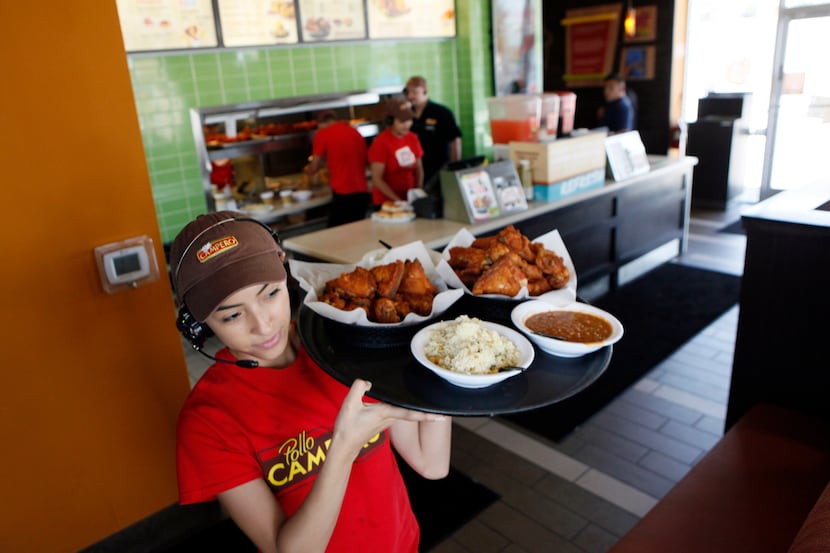
By Imelda García
9:53 AM on Apr 16, 2024 CDT
Pollo Campero, the Guatemalan-born chicken chain with a loyal following, has big plans for the United States.
The chain, which launched its U.S. headquarters in Dallas in 2007, opened its 100th U.S. location this month and plans to expand even more to gain market share in the fried and rotisserie chicken world. Its parent company, 103-year-old Corporación Multi-Inversiones, pledged to invest $190 million in the expansion over the next few years.
Pollo Campero, which is a fast-casual restaurant that sells fried and grilled chicken with typical Central American side dishes, such as yucca or plantains, started in Guatemala in 1971 and then expanded to El Salvador and other Latin American countries. By 2002, they entered the U.S. market.
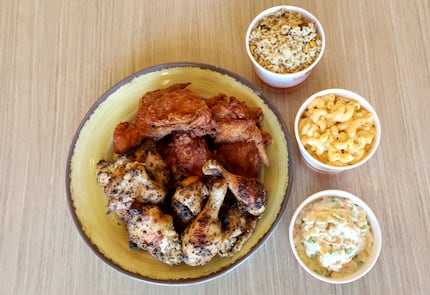
“We have a loyal following of Central Americans who are very passionate about the brand, not only because it is fresh food, but because they have memorable experiences when they go to the restaurants growing in their countries,” said Blas Escarcega, Pollo Campero’s vice president of franchise development, to The News . “When we open a restaurant here in the U.S., people get excited because they say, ‘Oh, that’s my brand, that’s home.’”
Pollo Campero has added other dishes to its menu to gain ground with American diners, such as mac and cheese and coleslaw.
The latest food and drink reviews, recipes and info on the D-FW food scene.
By signing up you agree to our Terms of Service and Privacy Policy
“We’re not only expanding to have more presence , but we are also adding things to the menu so our customers have more relatable things to order,” Escarcega said. “When people say chicken, I want them to say Pollo Campero.”
Another attraction of Pollo Campero is that the dishes are served with silverware, making it a place somewhere between a fast-food chain and a restaurant.
Pollo Campero aims to open 25 more restaurants in the U.S. in 2024. About 16% of U.S. locations are franchised, and the rest are corporate-owned. By 2026, the chain hopes to lift that number to 30%.
The company’s revenue increased 19% last year. According to a press release, each U.S. location averages over $2.9 million in annual sales.
In North Texas, Pollo Campero has two locations in Dallas, one in Farmers Branch, one in Irving, and one in Richardson. The chain has locations in 19 states and the D.C. area.
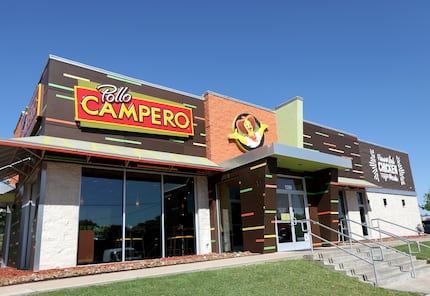
For Escarcega, part of the brand’s expansion in the United States in recent years is due to the greater acceptance of Hispanic culture in the country, boosted by social networks where new generations show their appreciation for cultural diversity.
“I do see the younger generation wanting to taste more flavors and experiment with different cultures; they are not afraid to try anything,” Escarcega said. “So this has allowed us to enter the more mainstream consumer here in the U.S., but you also bring along our legacy customers.”

Imelda García , Staff Writer . Imelda García is a journalist covering Hispanic food and Latino culture trends. She previously worked as a reporter for Al Día, the Spanish-language publication of The DMN. Before working at The DMN, she developed most of her career in national outlets in México.
Top Food Stories
Dallas-based tgi fridays plans to go public through acquisition by u.k. franchisee, bye corner bakery, hello hudson house at dallas’ preston and forest, world’s top golfer scottie scheffler visited this dallas bar after win at the masters, try this plano bangladeshi-fusion pizza shop for bengali new year in d-fw.
- Share full article
Advertisement
Supported by
The Fried Chicken Is in New York. The Cashier Is in the Philippines.
A few New York City restaurants are experimenting with virtual staff members, who greet customers onscreen via Zoom from the Philippines.

By Stefanos Chen
At Sansan Chicken in Long Island City, Queens, the cashier beamed a wide smile and recommended the fried chicken sandwich.
Or maybe she suggested the tonkatsu — it was hard to tell, because the internet connection from her home in the Philippines was spotty.
Romy, who declined to give her last name, is one of 12 virtual assistants greeting customers at a handful of restaurants in New York City, from halfway across the world.
The virtual hosts could be the vanguard of a rapidly changing restaurant industry, as small-business owners seek relief from rising commercial rents and high inflation. Others see a model ripe for abuse: The remote workers are paid $3 an hour, according to their management company, while the minimum wage in the city is $16.
The workers, all based in the Philippines and projected onto flat-screen monitors via Zoom, are summoned when an often unwitting customer approaches. Despite a 12-hour time difference with the New York lunch crowd, they offer warm greetings, explain the menu and beckon guests inside.
But skeptical customers said they were not eager to join this particular Zoom meeting.
“You hear ‘hello’ and you say, ‘What the hell is that?’” Shania Ortiz, 25, recalled of a recent trip to Sansan Ramen, a neighboring Japanese restaurant that had a gold-framed, flat-screen monitor set up in the foyer with a surveillance camera trained on guests. “I never engage,” she said.
The service is the brainchild of Chi Zhang, 34, the founder of Happy Cashier, a virtual-assistant company that was thrust into the spotlight last week, when a social media post about the overseas workers went viral.
He was caught off guard. The program has been quietly tested since October, but the company’s website has not yet been set up. The technology is already available in stores in Queens, Manhattan and Jersey City, N.J., including at Sansan Ramen, its sister store, Sansan Chicken, and Yaso Kitchen, a Chinese soup dumpling spot. Two other Chinese restaurants using the service on Long Island asked not to be named, he said.
Mr. Zhang is a former owner of Yaso Tangbao , a Shanghainese restaurant in Downtown Brooklyn that closed during the coronavirus pandemic. He said the experience reinforced the idea that restaurants were being squeezed by high rents and inflation, and that a virtual-assistant model, somewhat akin to that employed by overseas call centers, could help maximize small retail spaces and improve store efficiency.
When the virtual assistants are not helping customers, they coordinate food delivery orders, take phone calls and oversee the restaurants’ online review pages, Mr. Zhang said. They can take food orders, but they can’t manage cash transactions.
The workers are employees of Happy Cashier, not the restaurants. And Mr. Zhang said that their $3-an-hour wage was roughly double what similar roles paid in the Philippines.
Tipping policy is set by the restaurants, he said, with one giving its virtual greeters 30 percent of the pooled total each day.
The restaurant industry has long been an entry point for immigrants, and a hotbed for labor violations like wage theft.
But the Happy Cashier model is legal and minimum wage laws extend only to workers “who are physically present within the state’s geographical limits,” according to a spokesman for the New York State Department of Labor.
Mr. Zhang said he expected to quickly scale up by placing virtual assistants in more than 100 restaurants in the state by the end of the year.
The prospect is alarming, said Teófilo Reyes, the chief of staff at Restaurant Opportunities Centers United, a nonprofit labor group that has pushed for a higher minimum wage in New York.
“The fact that they have found a way to outsource work to another country is extremely troubling, because it’s going to dramatically put downward pressure on wages in the industry,” he said.
The fast-food work force is already shrinking, and new technology could further transform the industry, said Jonathan Bowles, the executive director of the Center for an Urban Future, a public policy think tank.
Fast-food restaurants in New York City had an average of 8.5 employees in 2022, he said, down from 9.23 in 2019, before the pandemic.
Virtual assistants have become common in customer service and corporate settings, but are rare in the hands-on restaurant business.
One recent exception came from Freshii, a Canadian restaurant brand that faced a backlash in 2022 over claims of outsourcing jobs, after partnering with a virtual cashier business called Percy.
Mr. Zhang said his business was different. “It’s a service, we are providing a tool. It’s up to them how to use this,” he said of his restaurant clients.
Brett Goldstein, 33, a founder of an artificial intelligence company who made the viral post about the virtual workers, said some commenters had described the model as dystopian while many others had been intrigued.
At the Sansan Chicken in Manhattan’s East Village, Rosy Tang, 30, a manager, praised the service.
“This is a way for small businesses to survive,” she said, adding that the cost and space savings it provided could allow her to add a small coffee stall to the store.
In practice, however, quirks with the model abound.
At the Sansan Chicken in Queens, the virtual assistant couldn’t help a reporter order a sandwich without cheese on a touch pad menu. The assistant said the reporter should order from the in-person staff members at the Sansan Ramen next door, which shares a kitchen with the chicken restaurant.
Will Jang, 30, an associate at Goldman Sachs, had lunch on Wednesday at the Yaso Kitchen in Jersey City — and completely ignored his virtual hostess, Amber.
“I thought it was some advertisement,” like the prerecorded videos in taxi cabs, he said.
Amber, who did not give her last name, took it in stride. After studying business administration in college, she said she worked in-person at a fast-food restaurant. She started this virtual job three months ago.
“It’s my first time to work in a work-from-home setup,” she said in front of a virtual backdrop emblazoned with mustachioed cartoon dumplings.
When asked where home was, she demurred.
“I’m sorry, I cannot share any more personal details with you,” she said. “Can I take your order?”
Nate Schweber contributed reporting.
Stefanos Chen is a Times reporter covering New York City’s economy. He previously covered real estate in the city for over a decade. More about Stefanos Chen
The future of fast food service? Cashiers are Zooming in from the Philippines to take your order at an NYC fried chicken joint

At Sansan Chicken in the East Village of Manhattan, a cashier will greet you with a wave and a smile—but they’ll be over 8,500 miles away. Instead of a human standing in front of you, you’ll instead see a face on a screen, working over video chat all the way from the Philippines. Brett Goldstein, an AI startup founder and owner of Launch House Ventures, stumbled upon the restaurant late Saturday night when he was hungry for Japanese fried chicken. He told Fortune it’s the future of fast food.
“I had this aha feeling of ‘Okay, this makes a lot of sense,’” he said.
Goldstein shared his experience at the chain on X . He said the service was friendly—more so than the average New York cashier—and that while he placed his order at a self-service kiosk, the cashier stood by and controlled the restaurant’s point-of-sale system in case he had any questions. After Goldstein was finished placing his order, he had an option to tip the remote cashier.
this is insane cashier is literally zooming into nyc from the philippines pic.twitter.com/opAyS8AYUs — brett goldstein (@thatguybg) April 6, 2024
Happy Cashier is the company behind the virtual cashiers, and a spokesperson confirmed that it hires employees from the Philippines to video-call into the restaurant.
The food was good, Goldstein said, despite his chicken katsu curry setting him back an “insane” $20. But the real talking point was the impact that virtual cashiers could have on the fast-food industry.
“Put yourself in the restaurateur’s shoes,” he told Fortune . “Minimum wage is going up. Rent is going up. Either they’re going to have to increase the cost of the food, which you can only do to an extent…or you can cut costs.”
Sansan’s virtual cashiers are part of a growing movement of restaurant automation and the introduction of technology that limits the number of human workers in a store at a given time. It’s particularly popular in the fast-food industry, where companies are looking to grow profit margins in a time of mandates increasing minimum wages for these workers.
“They have a clear niche; they’re not going to revolutionize their offering,” Daron Acemoglu, an economics professor at the Massachusetts Institute of Technology, told Fortune . “Their brand is to provide relatively cheap food, so labor costs matter more for them.”
Saving on steep labor costs
Labor accounts for 36% of an average restaurant’s costs, according to a March Bank of America note , and using automation to cut down on menial tasks while outsourcing labor to foreign workers could be a way to save money.
Mohammad Rahman, professor of management at the Mitchell E. Daniels, Jr. School of Business at Purdue University, told Fortune that hiring virtual workers, including those from the Philippines, would cost restaurants like Sansan only 10% of what they would pay in-person cashiers.
The Philippines has the largest business process outsourcing (BPO) industry in the world, generating a projected $35.4 billion in revenue in 2023, according to the Business Process Association of the Philippines. It has employed over 1.3 million Filipinos .
Rahman said that despite a $3.75 hourly wage—the rate for virtual cashiers in similar restaurant concepts—being a pittance for U.S. workers, it’s a substantive amount for workers in the Philippines. The $3.75 hourly wage is about $600 per month, translating to more than 33,900 Philippine pesos (PHP), which is well above the median monthly wage for Filipinos of 18,400 PHP, according to Statista .
“At the end of the day, every individual will make up their mind based on this,” Rahman said. “But it’s important to realize that these technologies can also be very liberating and contribute a lot to the struggling economies in the world.”
But hiring cashiers to work remotely has also raised concerns. Canadian fast-casual chain Freshii used Percy, a video calling system attached to its cash registers, as early as 2022 but did not speak publicly about the technology. An investigation from the Toronto Star found it was employing cashiers from Nicaragua to work for $3.75 an hour, which drew swift criticism, and the restaurant discontinued the service in August 2023, attributing it to a change in ownership. Though Ontario’s minimum wage is $16.55 , legal experts dubbed the use of Percy sound.
“It’s just like any other kind of outsourcing,” employment lawyer Jonathan Pinkus told the Star. “If you’re sending jobs to people in a different country, you’re only obligated to comply with the labor standards of that country. Being virtually present in Ontario doesn’t change that.”
Whether or not foreign workers stand to benefit, outsourcing this work puts fast-food restaurants in a precarious position, Acemoglu said. While virtual workers can be called upon in a time of U.S. labor shortages in the fast-food industry, those jobs could just as easily threaten workers looking for those minimum-wage jobs.
“If it displaces workers, especially in the local labor market, from the jobs that were open to them, that would have impacts on their livelihoods and communities,” he said.
A human touch
Virtual workers such as the ones at Sansan strike the sweet spot of automation, Rahman argued. While they save on labor costs, they provide the troubleshooting ability and warmth that completely automated self-service kiosks don’t have.
“Customers expect better services, so if you can bring in that person who is basically virtually there, this person can do all your customer service, just as if the server was just standing there,” he said. “As long as that experience is the same, the customer probably doesn’t care.”
Rahman said leaning more on virtual workers is likely inevitable. “What we’re seeing right now is just a natural evolution of the future of work,” he said.
Large language models such as ChatGPT and Google Gemini could make it possible for AI bots to take people’s orders and answer questions in a matter of a couple of years. AI drive-through company Presto Automation has installed its services in chains such as Del Taco and Checkers, though human workers are still doing much of the work behind the scenes.
But Goldstein, despite seeing the lucrative potential for increased automation in fast-food restaurants, admitted that it did feel a little dystopian to order his fried chicken from someone halfway across the globe. The transition from in-person workers to virtual workers, and maybe eventually to AI, diminishes the intangible draw of dining out in a big city.
“There’s nothing better than human connection, humanity, and personal connection. There’s something very special about physical presence,” Goldstein said. “That’s why we live in New York City.”
Latest in Retail
- 0 minutes ago

Frustrating flight cancellations, daylong waits prompt DOT to strike deal on airline consumer complaints

The U.S. is reportedly preparing to sue Ticketmaster over the monopolistic behavior that outraged Swifties last year

Fashion giant Shein has been slapped with yet another lawsuit alleging copyright infringement, data scraping, and AI to steal art: ‘It’s somewhat shocking that they’ve been able to get away with it’

TGI Fridays just got bought out by its largest franchisee after struggling for years

Beloved British retailer Superdry plans to quit the London Stock Exchange after mounting losses to overhaul the company and save it from going bust

Dr Martens appoints former Apple senior director as CEO; amid bleak earnings
Most popular.

Apple loses its spot as the world’s top seller of smartphones after tough China competition from brands like Xiaomi and Huawei

Some ex-TikTok employees say the social media service worked closely with its China-based parent despite claims of independence

Founder of Toms shoes went on a men’s retreat with other entrepreneurs to combat his loneliness and depression: ‘I lost a lot of my clear meaning and purpose’

Bill Gates unloaded one of his properties in less than two weeks on the market—and it only cost $5 million

The ‘Oracle of Wall Street’ expands on why the ‘crisis of the American male’ will send home prices crashing 30%: Gaming, rampant loneliness, and not enough single women homebuyers

The tax code is made for tradwives. Here’s how much it punishes dual-earning couples

IMAGES
VIDEO
COMMENTS
The take-out fried chicken market is projected to grow from $6.85 billion in 2023 to $10.52 billion by 2032, a 5.5% CAGR (Source - Market Research Future). Key factors driving the growth of the fried chicken industry include: Chicken's widespread popularity as an affordable, versatile protein source.
A business plan has 2 main parts: a financial forecast outlining the funding requirements of your fried chicken shop and the expected growth, profits and cash flows for the next 3 to 5 years; and a written part which gives the reader the information needed to decide if they believe the forecast is achievable.
Here is a sample business plan for starting a fried chicken shop. The different sections of this plan require you to conduct a thorough feasibility study. Without a good feasibility study, you will be setting yourself up for failure. However, you can avoid this by reading to the end and obtaining a general direction to take for your new business.
Step 3. Find a suitable location for your shop. After preparing your business plan, find a good location to open your shop where you can get more potential customers. Many people face difficulties finding a good location, but Your street and city are the best options for opening a food-based shop.
The next step to start a fried chicken shop is to choose the company's market positioning. Market positioning refers to the place your product and service offering occupies in customers' minds and how it differs from how competitors are perceived. Being perceived as a high-end solution, for example.
Writing a business plan for a fried turtle shop can be an intimidating chore, especially for those just starting. Such in-depth guide is designed to help entrepreneurs like you understand how to create a comprehensive shop design so that you can approach the exercise with method and confidence.
Section 4: Operations and Management. Once your fried chicken business is up and running, it's essential to focus on efficient operations and effective management to ensure its long-term success. This section will cover key aspects of running your business smoothly and meeting customer expectations.
Finding an Optimal Location. The first step in opening a fried chicken store is to find a location to rent or buy that will house your store. Location is critically important for a food outlet ...
A fast food business plan is a plan to start and/or grow your fast food restaurant. Among other things, it outlines your business concept, identifies your target customers, presents your marketing plan and details your financial projections. You can easily complete your fast food business plan using our Fast Food Business Plan Template here.
A fried chicken business is a type of food establishment that specializes in the production and sale of fried chicken products. It involves preparing and ... Starting a fried chicken business entails drafting a detailed business plan, conducting market research, securing funding, finding an ideal location, acquiring necessary licenses and ...
So, if you're someone who's thinking about starting a fried chicken restaurant business, we can tell you there are two ways to go about that: you can start from scratch and take on all the hard work and responsibilities yourself, or you can partner with a franchise brandlike Golden Chick, and enjoy the benefits that come with that partnership.
Published on 11/07/2021 08:00:00. When it comes to setting up a chicken restaurant franchise, creating a detailed business plan is a crucial part of the process. Planning and organisation are often the keys to success, and if you're interested in running your own chicken business successfully, this article will tell you everything you need to know about building a viable business plan.
Location: The location of your fried chicken shop can greatly impact the average price and number of monthly transactions. For example, if your shop is located in a busy city center, you may be able to charge higher prices and attract more customers. On the other hand, if your shop is located in a less populated area, you may need to adjust your prices and expect lower transaction numbers.
Step 3: Understand the Regulations, Licenses, and Insurance Requirements. If you're planning to open a fried chicken business, it's essential to understand all the regulations and licenses required. Don't forget about insurance, too—it's essential for any business. Research local regulations & licensing.
If you're looking to start a fast food restaurant or grow your existing one you need a business plan. A business plan will help you raise funding, if needed, and plan out the growth of your fast food restaurant in order to improve your chances of success. ... Sandwich Shop Business Plan Template. 100 Sample Business Plans. Business Plan ...
In this video, you will learn how to start a chicken shop business. Let's take a closer look at what goes into starting a chicken shop and how we can make yo...
Free Google Slides theme and PowerPoint template. Everyone loves fried chicken! It's not only a food, but a culture: getting all together, sharing a fun evening, maybe watching a game… if you want to open a business that offers all this, this business plan is the perfect ally for your team. Dip into these slides and share your projects in a ...
Fried chicken is one of the most popular -- and profitable -- endeavors in foodservice. Over the last several years, it's been at the top of several trends lists as a way to help operators improve their bottom lines, but a successful fried chicken program doesn't exist in a vacuum. It starts with an idea and ends in the fryer. A Winning Fried Chicken Recipe As a southern fried chicken purist ...
We offer you full support if you decide to open your own crispy-coated chicken restaurant. We offer flexible business relationship, one, which allows you to take advantage of the full range of solutions we offer, or only the ones you need. We will enable you to work independently, and we provide constant support. Use our experience and knowledge.
Business Plan 06 2. FFC - THE BRAND 2.2 Mission To provide an exceptional dining experience for the 2.1 Introduction entire family with above par fine dining services and cuisines that would satisfy the palatial taste of the FFC's - French Fried Chicken Restaurants LLC's, flavors customer. originate from a secret traditional recipe from France which was purchased by CIG Group of ...
Free Book for You: How to Start a Business from Scratch (PDF) A Step by Step Guide to Starting a Small Business. This is a practical manual in a PDF format, that will walk you step by step through all the essential phases of starting your Chicken Shop business. The book is packed with guides, worksheets and checklists.
Investment needed for your chicken shop business. Have at least Rs.1-to-2 lakh in funds set aside for investment. Store and storage are necessary to ensure that meat is appropriately preserved. To attract customers, your business should be located in a bustling market.
Service and Location As a small service business, Patrick's Spicy Fried Chicken has grown mainly through word of mouth. Spicy fried chicken will be cooked and served onsite, or sold online, and as such, the location of the business remains flexible and mobile. The Spicy Fried Chicken is made at home by the owners.
9:53 AM on Apr 16, 2024 CDT. LISTEN. Pollo Campero, the Guatemalan-born chicken chain with a loyal following, has big plans for the United States. The chain, which launched its U.S. headquarters ...
Delivery & Pickup Options - 9 reviews and 39 photos of Tenders "Tried a new spot and a local business. The fried chicken tenders were...great! Perfect crunch. Not over seasoned. Moist chicken. Very well done. They got a bunch of dipping sauces. But they need just a plain honey mustard to round it out. The fries were ok. They are those double fried ones which are extra crunchy I got the fried ...
The fried chicken wings were piping hot when we got them - super moist and crispy. It's a family-run business - the kids were hanging out in the front when we first walked in (it was a holiday). They offer a few different styles of fried chicken - we'll have to come back to try more items from the menu.
Victor J. Blue for The New York Times. Fast-food restaurants in New York City had an average of 8.5 employees in 2022, he said, down from 9.23 in 2019, before the pandemic. Virtual assistants have ...
Verified by the business 2 months ago. See all 43 photos Write a review. Add photo. Share. Save. Menu ... - Korean Fried chicken, purple rice, Japchae, pickled cabbage, sweet corn, kimchi, lettuce, edamame, bibimbop Sauce ... $$ Moderate Chicken Shop, Korean, Gastropubs. Steve's Bar-B-Que. 519 $$ Moderate Korean, Barbeque. T-Toust. 288
Rahman said that despite a $3.75 hourly wage—the rate for virtual cashiers in similar restaurant concepts—being a pittance for U.S. workers, it's a substantive amount for workers in the ...
Best fried chicken nearby. bone in, honey garlic, secret of deliciousness. Helpful 1. Helpful 2. Thanks 0. Thanks 1. Love this 0. Love this 1. Oh no 0. Oh no 1. Jackie D. Santa Fe, Oakland, CA. 0. 1. Mar 11, 2024. ... Claim your business to immediately update business information, respond to reviews, and more! Verify this business Explore ...